
- LNG Fundamentals
- LNG Shipping Knowledge
- Gas Tankers Familiarisation
- Prevention of Rollover in LNG Ships
- Rules for Ships Carrying Liquefied Gases
- Conversion of Ship to LNG as Fuel
- LPG Tanker Practice
- LNG Bunkering Operation
- Simulation Model for an LNG ferry
- Gas Production Operations
- Liquefied Gas Handling Principles
- Effects of Fire on LNG Carrier Containment Systems
- Transportation of Liquefied Natural Gas
- Gas Carrier Course
- Ship to Shore Access
- LNG Trade and Transport
- Quality Control of Cargo Handling Work in LNG Carriers
- Training for Liquefied Gas Tanker Cargo Operations
- ESD Arrangements for Liquefied Gas Carriers
- Types of ships
- Rules for Safe Carriage of Cargoes by Sea
- How to Buy the Best Sailboat?
- Sell Your Boat in 30 Days
- RONOMAR GMDSS Course
- CES/CBT tests

Strategies and Best Practices of Ballast Voyage for Liquefied Gas Carriers
Navigate ballast voyage for LNG carriers adeptly with this comprehensive guide, covering heel management strategies, considerations for gas-burning propulsion and reliquefaction plants, and additional insights for smooth sailing. Enhance your ballast voyage operations with expert advice and best practices.
Overview of Ballast Voyage
Heel management, heel management of lngcs with a gas-burning propulsion system, heel management of lng carriers with a reliquefaction plant, further considerations on ballast voyage.
For cargo/deck or related work, the status of the hazard or risk increases when the LNGC is fully laden, so significant maintenance, especially of an invasive nature, should be avoided unless it is critical to the safety of the ship.
Therefore, although following this guideline may increase the workload on ballast passage, it is a better time to manage non-essential work.
On the ballast passage, the main objectives are:
- cold conditioning of the cargo tanks, resulting in the best possible cold state on arrival at the load port;
- maximisation of the use of the LNG BOG from the retained heel, as a supplementary fuel source will help to conserve bunkers;
- maintenance of cargo tank pressures within design recommendations;
- completion of any potentially disruptive planned maintenance ( PM );
- with operator approval, completion of any cosmetic maintenance that is in or adjacent to a gas dangerous zone;
- completion of any E/R maintenance on the LNGC’s power plant that has the potential to cause blackout, loss of way through the water or a delay to the schedule;
- completion of any alarm or trip tests that could disrupt the schedule.
On the ballast voyage, the cold state of the LNGC’s cargo tank will be maintained according to the charterer’s requirements.
Maintaining the cold state allows the LNGC to start Terminal Operations for LNG or LPG Carrier after Arriving in Port loading at the terminal on arrival, reduces time in port and keeps turn-around time to a minimum. It will also determine the loading procedure required at the terminal.
On longer ballast voyages, the lighter fractions of the liquid can evaporate and, the CH 4 content will be minimal, with only the heavy fractions (for example, propane, butane, ethane) remaining. Consequently, this liquid mass will have a relatively high saturation temperature and density, which may prevent pumping because of the high ampere loads induced in the pump motor. As a coolant, it also becomes ineffective, carrying a risk of droplet entrainment into the LNGC’s vapour system. On extended ballast voyages, heel ageing is a phenomenon that the operator must consider.
Heel management will depend, primarily, on the type of propulsion and whether the LNGC is to arrive ready to load or not.
Heel management of an LNGC with a gas burning propulsion system will be determined by the charterer’s voyage orders. The following items may be considered:
- intended loading date;
- expected condition of the cargo tanks on arrival in the loading port;
- ballast voyage fuel mode.
If a gas only fuel mode is ordered by the charterer, the heel quantity will be determined by the Overview of Alternative Propulsion Systems for the LNG Vessel propulsion system consumption for the required voyage duration. In addition, sufficient heel will be retained for cargo tank cooldown prior to arrival.
Normal practice will be to take additional heel as a “buffer” in case of delayed loading or adverse weather conditions during the voyage.
The charterer may request that the cargo tanks, on arrival at the loading port, contain sufficient liquid at the bottom of each tank to perform the opening CTMS . This will be at or above minimum accuracy level of the CTMS .
Where LNG is used for pre-cooling of Low Duty Compressor(s) on the Liquefied Natural Gas Carriers LD compressors , such as on DFDE / TFDE ships, additional heel will be required to keep the spray pump running. In this case, the minimum restarting level of the spray pump is also taken into consideration.
Heel for cooldown is estimated through experience of the operator. Cooldown is usually done in a sequence of spraying so the amount of heel will be above the quantity stated in cooldown tables.
Most charterers will also have a limit on the heel quantity remaining at the end of the voyage.
An example of heel management:
- conventional membrane LNGC of 170 000 m 3 cargo tank capacity with DFDE propulsion;
- duration of voyage is 15 days + 1- day buffer;
- ship should arrive cold and ready to load;
- all tanks should contain liquid at or above minimum accuracy level of CTMS ;
- gas only mode to be used;
- the daily consumption of the LNGC at given speed is 210 m 3 /day (15 days + 1- day buffer = 3 360 m 3 );
- coolant required for ready to load on arrival is 600 m 3 .
The total heel required from the above calculation is 3 960 m 3 . As minimum CTMS accuracy level is to be maintained in the loading port, heel will be retained in all four cargo tanks.
- Cargo Tank No. 1 – 19 m 3 .
- Cargo Tank No. 2 – 37 m 3 .
- Cargo Tank No. 3 – 37 m 3 .
- Cargo Tank No. 4 – 34 m 3 .
Heel management on LNGCs with a reliquefaction plant is less demanding than on those with a gas burning propulsion system. This is because the reliquefaction plant is continuously running to condense evaporated BOG , giving the operator options for heel distribution and cargo tank cooldown.
Every operator will have a different approach to a ballast voyage where a reliquefaction plant is fitted.
Read also: Liquefied Natural Gas Reliquefaction Plant
There should be sufficient BOG available to run the reliquefaction plant. In addition, even though BOG is not consumed, there is still an efficiency aspect of the ballast passage to consider. The reliquefaction plant should not run on loads higher than required for cargo tank management as this would mean an increased fuel consumption for power generation. An optimum operational practice for such an LNGC is a ballast voyage with heel retained in all cargo tanks, so that the cargo tank bottom is kept cold and less cooldown is required, while sufficient BOG for plant operation is provided.
An advantage of the system is the availability of condensate return, which can be utilised for continuous maintenance of the cargo tank temperature without the need for a spray pump. A disadvantage is the high power demand of some reliquefaction plants, with a subsequent higher fuel consumption.
Whenever the spray pump is in use generated BOG is increased, increasing the need for reliquefaction. However, it is good practice to avoid constant changes in the load and the use of condensate return will provide this.
Whichever principle of heel distribution is used the limitations of cargo tanks must be considered. Moss type cargo tanks can be loaded to any partial condition, but membrane tanks must be kept outside of their sloshing limits.
Sloshing limits will be clearly stated in the ship’s certificates and documentation and must be strictly complied with.

- The international group of liquefied natural gas importers (GIIGNL). LNG custody transfer handbook / 6 th Edition: 2020-2021.
- ©Witherby Publishing Group Ltd. LNG Shipping Knowledge / 3 rd Edition: 2008-2020.
- CBS Publishers & Distributors Pvt Ltd. Design of LPG and LNG Jetties with Navigation and Risk Analysis / 4 th Edition.
- NATURAL GAS PROCESSING & ITS ENERGY TRANSITION ROLE: LNG, CNG, LPG & NGL Paperback – Large Print, November 14, 2023.
- OCIMF, ICS, SIGTTO & CDI. Ship to Ship Transfer Guide for Petroleum, Chemicals and Liquefied Gases / 1 st Edition, 2013.
- The Society of International Gas Tanker and Terminal Operators (SIGTTO). Ship/Shore Interface / 1 st Edition, 2018.
Did you find mistake? Highlight and press CTRL+Enter
You are using an outdated browser. Please upgrade your browser to improve your experience.
For full functionality of this site it is necessary to enable JavaScript. Here are the instructions how to enable JavaScript in your web browser.
- Register for LNG Industry magazine

- Special reports
Balance the BOG
Save to read list Published by Lydia Woellwarth , Editor LNG Industry , Monday, 07 June 2021 12:00
Maksym Kulitsa, Independent FSRU Operations Consultant, Ukraine, and David Wood, DWA Energy Limited, UK, detail the advantages of keeping boil-off gas well balanced.
This article presents the full version of the overview article published in the June 2021 edition of LNG Industry. It describes a new balanced boil-off gas method for cooling down LNG carrier tanks at sea in preparation for loading, so as to reduce the coolant LNG quantity consumed during a voyage.
Cooling down the cargo tanks of LNG carriers prior to the ships arrival at discharge and loading ports follow various widely adopted operating procedures. The tank cool-down procedures typically followed cannot though be considered as best practice, because they consume considerable boil-off gas (BOG) while reducing tank temperatures. An alternative tested method, described here, consumes considerably less LNG during the tank cool-down process, which is beneficial, particularly during the ballast voyages. In certain circumstances LNG carriers consume liquid marine fuels so that they are able to preserve enough LNG heel to complete tank cool down at sea to required low temperatures before reloading can be commenced. The novel method devised for cooling down LNG carriers, particularly those fitted with membrane cargo tanks, at sea prior to arrival at a loading terminal involves much lower LNG heel consumption that conventional methods. The BOG-balanced tank cool-down method applies continuous spraying, at very low rates, of the tanks with LNG extracted from the heel. This procedure enables the ship’s engines to consume all excess BOG without the need to pass some of it as waste for combustion in the gas combustion unit or steam dump. It also ensures that the LNG cargo tanks are maintained at stable and constant pressure and reduces the coolant LNG quantity consumed. The BOG-balanced tank cool-down is straightforward to implement and monitor, simplifying tank pressure control. Test results demonstrate that tank cool-down rates of 4°C/hr to 5°C/hr can be maintained such that tank temperatures can be reduced from 30°C to -130°C within 37 hours. The method could work on LNG carriers with Moss-type tanks but is likely to be less effective as they are typically fitted with fewer tank spraying nozzles.
Introduction
Today’s tendency in LNG transport over sea is to minimise fuel spent and to maximise cargo delivered to discharge ports with minimum environmental impact. In recent years new technology has made significant advances in reducing engine fuel consumption, compared to the decades when the LNG shipping fleet consisted only of steam-powered ships. The past decade or so has seen the introduction of dual-fuel diesel electric (DFDE), and M-type electronically controlled gas injection (ME-GI) and other fuel-efficient marine engines on LNG carriers, as well as improved LNG cargo tank designs. However, the requirements to efficiently control and handle BOG is a common feature to all LNG carriers. 12
Total voyage consumption of LNG is not only dependent on engine efficiency, it is influenced by other inherent operations during the voyage. Reducing the LNG heel required for tank cool down prior to arrival at a loading port leads to an overall reduction in LNG spent during a voyage. During cooling down at sea, excess of BOG is consumed in the gas combustion unit (GCU) on DFDE or steam dump (SD) on steam vessels. Such consumption provides no commercial benefit from that BOG and leads to atmospheric emissions. Thus, minimising this consumption directly increases the overall commercial and environmental performance of an LNG carrier.
The mandatory Ship Energy Efficiency Management Plan (SEEMP) 10 , EU MRV (EU Monitoring, Reporting and Verification of CO 2 ; data collection became mandatory 1 January 2018) and IMO DCS (IMO Data Collection System on fuel consumption; data collection became mandatory 1 January 2019) 3,7 all focus on fuel and emissions reduction. Under the requirements of the SEEMP there is a substantial opportunity to benefit from more efficient operational practices tailored to modern LNG carrier designs, in parallel with developing more efficient engine designs. Although the reliquefaction of BOG is technically feasible on LNG carriers 2,9,14 , few vessels are fitted with such facilities and therefore require proactive BOG management.
Tank pressure behaviour in marine LNG tanks is complex, 8 being influenced by many variables including the temperature and composition of the LNG cargo, and requires careful management. 11,13,15 Changes in the composition, due to weathering effects of the LNG cargo over the timescale of single LNG carrier voyages, further complicate by evolving conditions in LNG cargo tanks 16 and the conditions of the insulation space. 1 This makes prediction and modelling of BOG rates in LNGC for cargo management purposes challenging. 4,5,6
Procedures to cool down LNG carrier cargo tanks prior to arrival at discharge ports are in common use. However, the traditionally accepted method to conduct tank cool down cannot be considered as best practice, be-cause an alternative method consumes less LNG for tank cool down. Additionally, sometimes there are situations where liquid marine fuels need to be consumed in order to preserve enough LNG heel for tank cool down at sea. This occurs if insufficient heel cargo is available due to excess fuel consumption on the ballast voyage due to delays or bad weather. The cost of marine diesel for engine fuel is much higher (e.g. US$700/t at the beginning of 1Q20) than BOG, and results in more atmospheric emissions.
A novel method is described for cooling down the LNG carrier membrane cargo tanks at sea prior to arrival at a loading terminal that requires minimum LNG heel consumption. The method described can also work in Moss-type, spherical rigid LNG tanks but tends to be less effective.
Cool-down issues for LNG cargo tanks prior to reloading
LNG carrier cargo tanks are routinely cooled down at sea shortly prior to arrival at a loading terminal. The typical scheme used for membrane LNG tanks is intermittent spraying twice a day (morning and evening) for three days prior to arrival at the loading terminal. The LNG quantity used for cooling down LNG carrier tanks at sea ranges from 800 m 3 - 1600 m 3 LNG. That typically involves three warm tanks and one semi-cold LNG heel tank being cooled downed at sea. That consumption and related LNG heel needed to achieve it, directly influences an LNG carrier’s commercial performance, as more heel cargo has to be retained for the ballast voyage, enabling the ship to deliver less commercial cargo in the previous laden voyage. This traditionally used method for tank cool down at sea is convenient but is wasteful and not the optimal way to achieve it. Additionally, in rare cases, the marine diesel consumed in the engine for the sake of preserving enough LNG heel for tank cool down, is a further commercial disadvantage.
A common tank-cooling method applies a high-spraying regime for limited period of time. This increases the tank pressure to approximately 65 - 70% of Maximum Allowable Relief Valve Setting (MARVS), which is 250 mbarg for the tank. At that point spraying is discontinued to allow time to dispose of all the generated BOG into the LNG carrier’s engines and/or to the GCU or SD. Many operators do not introduce any LNG, even a small amount, into the tanks after the cooling-down is completed. This cooling-down schedule leads to high LNG heel consumption. The BOG extracted is involved not only in cooling down the tanks (Table 1). It is also used to cool down the LNG heel itself and re-cooling the tanks, which are warming up between spray sessions. The BOG quantity required for cooling the LNG heel prior to the next tank spraying session is not large but contributes to extra consumption. The extra LNG consumed (wasted) in repeatedly reheating tanks between spray sessions and can amount to 300 - 400 m 3 LNG. That constitutes between 30 - 50% of all the LNG consumed at sea during the traditional cool-down regime.

The minimum LNG quantity required by the design case cool-down tables for cooling down alongside the terminal jetty is achieved by continuous spraying for 10 - 15 hours, depending on the type of membrane tanks. LNG consumption at sea usually is double that quantity using the intermittent cool down method.

Another issue with this method that sometimes operators tend to allow higher cooling rates than stated in their own cool-down tables. This is not good practice for the tank structure due to the excessive thermal stress it potentially suffers (particularly to the pump tower). Also, there is not a standard way to calculate the quantity of LNG heel required for tank cool down at sea for ballast voyages. Approaches to this vary from operator to operator. Such calculations should be performed with reference to the cool-down tables issued by the tank manufacturer. These facilitate the correct estimation of LNG consumption based on higher heating value (HHV) of the actual LNG cargo transported relative to the cool-down table’s HHV.
In cases where the LNG heel is calculated simplistically, it may result in an LNG carrier arriving at a loading terminal with a substantial quantity of LNG heel remaining on board (e.g. up to 0.6 -1.0% of total cargo capacity). Consequently, less LNG can be loaded for onward transport. In some rare cases, insufficient heel may result in an LNG carrier being unable to sufficiently cool down its tanks and this may lead to rejection of that ship by the loading terminal, or necessary to burn expensive fuel oil in order to preserve enough heel for tank cool down. These cases both impair an LNG carrier’s commercial performance at the expense of their charterers.
It is not possible to achieve the ‘alongside-jetty’ cool-down LNG consumption quantity at sea. However, a novel BOG-balanced method is proposed to conduct tank cool-down at sea with LNG consumption close it.
Method to cool down LNG carrier cargo tanks at sea
A novel method for at-sea tank cool down exploits the ability to burn a certain amount of BOG generated during cool-down in the LNG carrier’s engine, GCU or SD, without venting while conducting continuous tank spraying at slow rates. Ballast LNG carrier voyages typically follow two operating patterns as they approach the loading terminal: 1) vessel moves at high speed during the cool-down regime; and 2) vessel has to cool down at anchor or at slow speeds. The LNG carrier’s propulsion system, and the capacity of its GCU or SD define the BOG quantity that an LNG carrier is capable of handling per hour and per day. The BOG-balanced method of tank cool down involves continuous spraying of LNG in the tanks at such slow rates that the engine and/or GCU/SD will burn all BOG excess immediately. This causes the tank pressure to remain approximately constant.
The BOG-balanced method is easy to calculate based on the tank manufacturers cool-down tables. The cooling energy stated in million/Btu units in the cool-down tables is divided by HHV (in million/Btu) of the actual LNG heel. This ratio determines the quantity of the specific LNG that needs to be evaporated in order to lower the tank temperatures from their prevailing temperature to a specified ‘ready to load’ temperature. For GTT tanks that is -130°C determined as the average of the temperatures recorded in accordance with cooling-down tables.
Knowing the total LNG required to cool the three warm cargo tanks and the semi-cold heel tank and knowing the expected total possible gas consumption by engine and GCU/SD for specific voyage conditions, the time needed for tank cool down can be estimated. Specifically, to derive the tank cool-down time required, the quantity of LNG consumed to achieve ‘cold temperature’ (minus extra accumulated vapour in the tank due to vapour shrinkage) is divided by the available BOG handling capacity rate at sea. This varies depending on voyage conditions. A uniform LNG tank cool-down rate can then be applied continuously for that time period for all tanks. That rate will be substantially lower and safer (avoiding potential tank damage) than a more rapid cool-down rate.
For example, to cool an LNG carrier’s tanks down from 30°C to -130°C (using cool-down tables) 680 m 3 of LNG (i.e. 306 t of LNG to evaporate) is required for cool down. Some vapour will accumulate in the tanks at a colder state. Therefore, the difference in total mass of vapour in the tanks, be-fore and after cool down, will be approximately 123 t (approximately 278 m 3 ) for an LNG carrier of 160 000 m 3 capacity. Thus, only 183 t of BOG needs to be evacuated from the tanks.
The time required for balanced tank cool down at a total BOG consumption of 5 tph would require approximately 37 hours to complete. Continuous spraying at an average total rate of 18.5 m 3 /hr LNG would be required. Continuous spraying would therefore begin 37 hours before the loading terminal pilot arrives on board. From spray-nozzle performance curves (Table 2), it is also necessary to establish a spray pressure at the nozzles such that in total they spray continuously at 18.5 m 3 /hr LNG. This maintains a balance between the LNG sprayed in the tanks and excess BOG extracted from the tanks. Table 2 indicates spraying pressures required when cooling a 0.25 barg for three spray coils and 0.33 barg for two by two spray coil configurations (two tanks sprayed alternately). The number of LNG spray nozzles and their spraying capacity should be considered when defining the spray pressure in each tank (Figure 2).
The cooling progress is easy to monitor and control during such method as the cool-down rate can be controlled at 4 - 5°C/hr in order for tank temperature to descend from 30 to -130°C within 37 hours (Figure 4).
Some additional adjustments need to be made to the cool-down LNG required. The exact LNG quantity needed for tank cool down should consider a small margin of spare capacity in case of vessel delays and the requirement for an extended cooling period (i.e. more than 37 hours in the example described). It should also be adjusted to account for some excess natural heat ingress into the tanks and loading pipework during the cooling period. Some additional time also needs to be allocated for the LNG heel to be transferred into each of the cooled tanks after cooling-down, if necessary. Typically, accurate tank gauging radar will require at least 6 - 10 cm of LNG level on even keel conditions in each tank. A more accurate minimum LNG quantity needed for tank cool down at sea can be estimated considering the adjustments mentioned.

The BOG-balanced method plans to achieve ready-for-loading tank temperature conditions on the arrival moment at the loading terminal or, ideally, close to the moment that the loading gauge opens. In which case it is not actually necessary to transfer heel LNG into the cooled tanks. This means that even less LNG and time are consumed for tank cool down purposes.

Figure 3a and 3b illustrate the temperature and pressure trends established during typical three day intermittent LNG carrier tank cool-down at sea, where it consumed approximately 1046 m 3 of LNG.

Figure 4 illustrates the BOG-balanced tank cool down method, where only approximately 680 m 3 of LNG is consumed, i.e. approximately 65% of that consumed using the intermittent method. Figure 4 also shows a comparison of the typical intermittent LNGC tank cool down method (three days cooling in advance of arrival) and BOG-balanced tank cool down method. The BOG balanced method results in approximately 4 - 5°C/hr continuous temperature descent during the cool-down period at sea, and generally no need for LNG heel transfer. Here, the BOG-balanced method of cool down is faster (37 vs 68 hrs) and consumes approximately half the LNG heel, while providing fine tuning of tank pressure.
By using approximately 500 m 3 less LNG for tank cooling-down for each ballast voyage, the approximate commercial benefit of the BOG-balanced method would amount to US$588 600/yr for an LNG carrier making 10 voyages, assuming a delivered sales gas price of US$5/mm Btu and an energy conversion for LNG of 23.54 mm Btu/m 3 .
Benefits of a BOG-balanced cool down of LNG carrier tanks at sea
The method allows tank cool down to be conducted in an optimal, controlled, and safe manner that requires minimum LNG heel at sea to be consumed for tank cool down. This improves the commercial performance of LNG carriers for the benefit of charterers.
The method can be easily planned using spreadsheet calculations using actual LNG quality and voyage schedule information for each specific LNG carrier voyage. This provides a standardised approach to LNG heel calculations and minimises the potential for operator’s error in heel estimation.
- The method allows for flexibility to make adjustments relating to loading schedule delays, which from time to time inevitably occur. In case of loading delay, the LNG heel also can be spread in cold tanks to minimise heating up. In such circumstances only a few hours of tank recooling is required, and in the worst case, tank cool down is finalised at the jetty. Jetty re-cool-down time is likely to fit within the laytime allowance of the LNG carrier charter party.
- Cool down can be stopped at any moment without the risk of venting over-heated vapour. This makes it easy to adapt schedule and keep tank pressure below 70% MARVS.
- LNG carrier tank cool down can always be conducted intermittently if too much BOG is generated and cannot be burnt effectively (i.e. slower vessel speed or at anchor). An alternative approach in such conditions is to spray each tank more intensely in frequent bursts, one tank in turn, for short periods. The only constraints that need to be adhered to are: 1) minimising the total time that each tank is allowed to warm; 2) not allowing tank pressure to rise above 65 - 70 % MARVS due to vapour expansion; and, 3) observing the designated cool-down rates for the specific tank.
- The method does not result in excess nitrogen consumption in the insulation barriers surrounding the tank as the tank cool-down rate is slow. In contrast, at high tank spraying rates nitrogen consumption can be a limiting factor.
- Application of this method does not require any extra knowledge or training for the ship crew as the simple calculations required can be standardised on a spreadsheet.
- Reduced atomisation of sprayed LNG due to lower spray pressure is not a problem for tanks at temperatures higher than -140°C and would not lead to LNG accumulating in the tanks before cool-down is completed.
- On vessels with liquefaction or partial liquefaction system, the cool-down task is easier with the BOG balancing method and the quantity of LNG heel required can be reduced.
Despite LNG carrier technology improving significantly in recent years, most operators have yet to achieve best to unleash the full potential of modern vessel designs. Improvements in efficiency in terms of total LNG consumption and atmospheric emissions during voyages can be achieved for all membrane LNG carriers. A new improved method of cooling down LNG carrier cargo tanks at sea prior to reloading is an example of such an improvement. It ensures the minimum LNG heel is consumed at sea in achieving that objective. It thereby improves the vessel’s overall commercial performance. The method is sufficiently flexible to adjust for changing operating conditions and loading schedule amendments for any LNG carrier with membrane tanks. The method may also work on Moss-type ships, subject to trial testing to establish its effectiveness with the small number of spray nozzles available in such tanks. From an improved design perspective, to optimise the BOG-balanced cool-down method, it would be beneficial to modify one spray coil per tank to consist of a reduced number of spray nozzles in new-build vessels. This would make the tanks in those vessels easier to spray at sea at low rates with improved LNG atomising, making the BOG-balanced cool-down method even more flexible and controllable.
1. CAO, J., ZHANG, X., ZOU, X. Pressure Control of Insulation Space for Liquefied Natural Gas Carrier with Nonlinear Feedback Technique. J. Mar. Sci. Eng. 2018, 6 (133) 11 pages. doi:10.3390/jmse6040133
2. choi, j. development of partial liquefaction system for liquefied natural gas carrier application using exergy analysis. international journal of naval architecture and ocean engineering. 2018, 10: 609-616., 3. dnv-gl. 2019. eu mrv and imo dcs. [accessed 5 may 2021] https://www.dnvgl.com/maritime/insights/topics/eu-mrv-and-imo-dcs/index.html, 4. dobrota, d., lalic, b., komar, i. problem of boil-off in lng supply chain. trans. marit. sci. 2013, 2(2): 91-100., 5. glomski, p., michalskii, r. problems with determination of evaporation rate and properties of boil-off gas on board lng carriers. j. polish cimac 2011, 6(1): 133-140., 6. grotle, e.l., esoy, v. dynamic modelling of the thermal response enhanced by sloshing in marine lng fuel tanks. appl. therm. eng. 2018, 135(5): 512-520., 7. ics-shipping. 2015. european union monitoring, reporting and verification (eu mrv) regulation. international chamber of shipping guidance 13 pages. https://www.ics-shipping.org/wp-content/uploads/2020/08/ics-guidance-on-eu-mrv.pdf [accessed 5 may 2021]., 8. kulitsa, m., wood, d.a. duality in lng tank-pressure behaviour and its relevance for ship to- ship transfers to floating storage and regasification units (fsru). adv. geo-eng. res. 2020, 4(1) 54-76. doi: 10.26804/ager.2020.01.06, 9. li, y., chen, x., chein, m.h. flexible and cost-effective optimization of bog (boil-off gas) recondensation process at lng receiving terminals. chem. eng. res. des. 2012, 90(10): 1500-1505., 10. mepc. 2016. guidelines for the development of a ship energy efficiency management plan (seemp). resolution mepc.282(70), adopted by the marine environment protection committee 28 october 2016. https://gmn.imo.org/wp-content/uploads/2017/05/mepc-28270-2017-seempguidelines.pdf [accessed 5 may 2021]., 11. migliore, c., tubilleja, c., vesovic, v. weathering prediction model for stored 850 lng. journal of natural gas science and engineering, 2015, 26: 570-580., 12. mokhatab, s., mak, j.y., valappil, j.v., et al. handbook of liquefied natural gas. oxford, uk: gulf professional publishing, 2014., 13. pellegrini, l.a., moioli, s., brignoli, f., bellini, c., 2014. lng technology: the weathering in above-ground storage tanks. ind. eng. chem. res. 2014, 53 (10): 3931-3937., 14. shin, y., lee, y. p. design of a boil-off natural gas reliquefaction control system for lng carriers. appl. energy 2009, 86 (1): 37-44., 15. wood, d.a., kulitsa, m. a review: optimizing performance of floating storage and regasification units (fsru) by applying advanced lng tank pressure management strategies. int. j. energ. res. 2018a, 42(4): 1391-1418., 16. wood, d.a., kulitsa, m. weathering /ageing of lng cargoes during marine transport and processing on fsu and fsru. journal of energy resources technology, 2018b 140 (10): 102901 (11 pages). https://doi.org/10.1115/1.4039981.
Read the article online at: https://www.lngindustry.com/special-reports/07062021/balance-the-bog/
You might also like

Seapeak becomes first shipping company to join UN OGMP 2.0
Seapeak has announced its official membership in the Oil and Gas Methane Partnership (OGMP 2.0).
Embed article link: (copy the HTML code below):
This article has been tagged under the following:
LNG carrier news
This content is available to registered readers of our magazine only. Please sign in or register for free.
Benefits include
- Access to locked videos & articles
- Downloadable white papers
- Full website access
Register for free » Get started now for absolutely FREE, no credit card required.
Already a member? Sign in here

The risk of ballast voyage for LNG carrier
Depending upon ship design, it may be necessary to undertake loading / de-ballasting or discharging / ballasting operations simultaneously. If this is the case, consideration should be given to the stability of the ship, especially to free surface effect in tanks, correct use of cargo tank centerline bulkhead valves, and cargo and ballast distribution to ensure adequate stability. Care should also be taken to ensure that the weight distribution does not lead to excessive trim, list or stress in transverse and longitudinal directions.
Concern about the introduction of alien organisms into environmentally sensitive waters and adjacent areas has prompted some national administrations to establish controls on the discharge of ballast water from ships. If it is necessary to change ballast at sea, the same care and attention must be paid to trim, stress and stability.
Though vessels, while sailing under ballast condition, have cargo tanks in two different conditions : one where propane or butane liquid is retained as coolant, and the other where only a small amount of liquid left over; the liquid left over evaporates and is gathered in coolant tanks and thus the latter will be filled with gas only.
Operations until arrival at a loading port include creation of the gas atmosphere according to a cargo loading plan and cooldown of each tank to the temperatures required at the loading port.
On the ballast passage, in addition to dealing with excess vapour produced as the remaining cargo boils, the temperature of the tanks also has to be controlled so that on arrival at the loading terminal, the vessel berths in a ready to load condition. Boil of gas creating pressure rises is dealt in the same way as on the loaded passage i.e. burned as fuel in the boilers.

Cooling of the cargo tanks differs between Moss vessels and Membrane vessels
Membrane type
On short voyages, it is normal for the liquid heel to be retained in each tank to keep the vessel cold enough during the voyage to berth ready to load but precautions should be taken that spray pump can be started at any time during voyage as necessary to arrive with average cargo tank temperature of -130degC or lower.
On longer voyages, it is now recommended that the majority of the heel is retained in one tank, and that other tanks are sprayed on passage to cool them down. BOG on membrane ships is burned as usual as fuel.
Liquid is taken from heel retained at the discharge port and sprayed into the cargo tanks using the in-tank spray pumps and nozzles. During the spraying additional vapour is generated which has to be used as BOG in the boilers. The following items should be among those monitored during the spraying.
- Cargo tank pressure.
- Cargo tank temperature.
- Vapour header pressure.
- Cargo tank level.
- Equator temperature.
- Cargo hold.
- Spray pump condition.
Once all equator temperatures are at the planned value or below, stop spray pump. Remember to keep at least one spray valve open at each tank to avoid pressure increases in the line.
Read more :
- Bulk Oil Cargo
- Completion of Documentation For Bulk Oil Cargoes
- Shortage and Contamination Claims For Bulk Oil Cargoes
- Ship concept design
- Maintain safe stability onboard
Indonesia Marine Equipment
INAMEQ is provide all marine product (equipment and sparepart) and news about marine product to help procurement team at shipping industry, ship contractor, port contractor and oil gas company finding competitive price to directly connect with manufacturer and authorized local and international.
Similar Posts

Design and components of sailing ships

Ship Design Theory
Leave a reply cancel reply.
This site uses Akismet to reduce spam. Learn how your comment data is processed .
Discover more from Inameq
Subscribe now to keep reading and get access to the full archive.
Type your email…
Continue reading
- Ballast Water Management
- Marine Environment
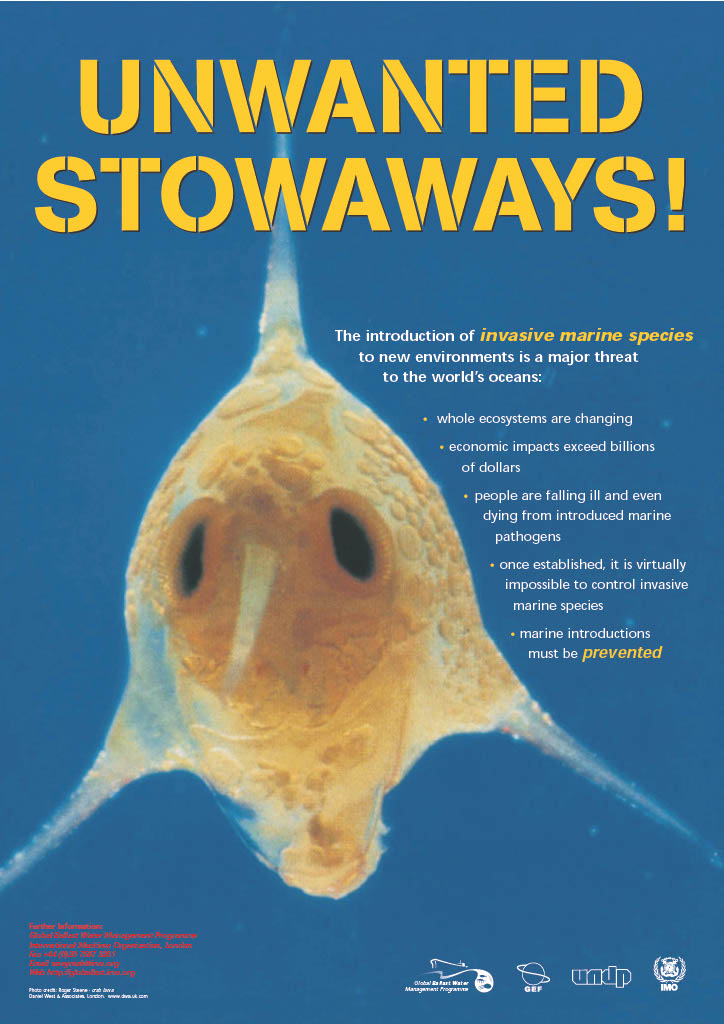
Since the introduction of steel-hulled ships , water has been used as ballast to stabilize ships at sea. Ballast water is pumped in to maintain safe operating conditions throughout a voyage. This practice reduces stress on the hull, provides transverse stability, improves propulsion and manoeuvrability, and compensates for weight changes in various cargo load levels and due to fuel and water consumption.
While ballast water is essential for safe and efficient modern shipping operations, it may pose serious ecological, economic and health problems due to the multitude of marine species carried in ships’ ballast water. These include bacteria, microbes, small invertebrates, eggs, cysts and larvae of various species. The transferred species may survive to establish a reproductive population in the host environment, becoming invasive, out-competing native species and multiplying into pest proportions.
Scientists first recognized the signs of an alien species introduction after a mass occurrence of the Asian phytoplankton algae Odontella (Biddulphia sinensis) in the North Sea in 1903. But it was not until the 1970s that the scientific community began reviewing the problem in detail. In the late 1980s, Canada and Australia were among countries experiencing particular problems with invasive species, and they brought their concerns to the attention of IMO's Marine Environment Protection Committee (MEPC).
The problem of invasive species in ships’ ballast water is largely due to the expanded trade and traffic volume over the last few decades and, since the volumes of seaborne trade continue to increase, the problem may not yet have reached its peak yet. The effects in many areas of the world have been devastating. Quantitative data show that the rate of bio-invasions is continuing to increase at an alarming rate and new areas are being invaded all the time.
For some examples of aquatic bio-invasions causing major impact please click here . It should be noted, however, that there are hundreds of other serious invasions which have been or are in the process of being recorded around the world.
Global response
Preventing the transfer of invasive species and coordinating a timely and effective response to invasions requires cooperation and collaboration among governments, economic sectors, non-governmental organizations and international treaty organizations; the UN Convention on the Law of the Sea (Article 196) provides the global framework by requiring States to work together to prevent, reduce and control pollution of the marine environment including the intentional or accidental introduction of species, alien or new, to a particular part of the marine environment, which may cause significant and harmful changes thereto.
IMO has been at the forefront of the international effort by taking the lead in addressing the transfer of invasive aquatic species (IAS) through shipping. In 1991 the MEPC adopted the International Guidelines for preventing the introduction of unwanted aquatic organisms and pathogens from ships' ballast water and sediment discharges (resolution MEPC.50(31)); while the United Nations Conference on Environment and Development (UNCED), held in Rio de Janeiro in 1992, recognized the issue as a major international concern.
In November 1993, the IMO Assembly adopted resolution A.774(18) based on the 1991 Guidelines, requesting the MEPC and the Maritime Safety Committee (MSC) to keep the Guidelines under review with a view to developing internationally applicable, legally-binding provisions. While continuing its work towards the development of an international treaty, the Organization adopted, in November 1997, resolution A.868(20) - Guidelines for the control and management of ships' ballast water to minimize the transfer of harmful aquatic organisms and pathogens , inviting its Member States to use these new guidelines when addressing the issue of IAS.
After more than 14 years of complex negotiations between IMO Member States, the International Convention for the Control and Management of Ships' Ballast Water and Sediments (BWM Convention) was adopted by consensus at a Diplomatic Conference held at IMO Headquarters in London on 13 February 2004. In his opening address to the Conference the Secretary-General of IMO stated that the new Convention would represent a significant step towards protecting the marine environment for this and future generations. “Our duty to our children and their children cannot be over-stated. I am sure we would all wish them to inherit a world with clean, productive, safe and secure seas – and the outcome of this Conference, by staving off an increasingly serious threat, will be essential to ensuring this is so”.
The Convention requires all ships to implement a Ballast Water Management Plan. All ships have to carry a Ballast Water Record Book and are required to carry out ballast water management procedures to a given standard. Parties to the Convention are given the option to take additional measures which are subject to criteria set out in the Convention and to IMO guidelines.
Several articles and regulations of the BWM Convention refer to guidelines to be developed by the Organization, and Conference resolution 1 invited IMO to develop these guidelines as a matter of urgency and adopt them as soon as practicable and, in any case, before the entry into force of the Convention, with a view to facilitating global and uniform implementation of the instrument.
The MEPC, at its fifty-first session in April 2004, approved a programme for the development of guidelines and procedures for uniform implementation of the BWM Convention, listed in Conference resolution 1, including additional guidance required but not listed in the resolution. The programme was further expanded at the fifty-third session of the MEPC in July 2005 to develop and adopt 14 sets of Guidelines, the last one being adopted by resolution MEPC.173(58) in October 2008.
The Guidelines, some of which have been revised since their initial adoption, and a number of other relevant guidance documents can be accessed here .
Approval of ballast water management systems
During the Convention development process, considerable efforts were made to formulate appropriate standards for ballast water management. They are the ballast water exchange standard and the ballast water performance standard. Ships performing ballast water exchange, which is a transitional option, shall do so with an efficiency of 95 per cent volumetric exchange of ballast water, while ultimately ships shall meet a performance standard based on agreed numbers of organisms per unit of volume of discharged ballast water.
Regulation D-3 of the BWM Convention requires that ballast water management systems used to comply with the Convention must be approved by the Administration taking into account the Guidelines for approval of ballast water management systems (G8). The Guidelines (G8) have been revised in 2016 and converted into a mandatory Code for Approval of Ballast Water Management Systems (BWMS Code), which was adopted by MEPC 72 (April 2018) and entered into force in October 2019.
Regulation D-3 also requires that ballast water management systems which make use of Active Substances to comply with the Convention shall be approved by IMO in accordance with the Procedure for approval of ballast water management systems that make use of Active Substances (G9). Procedure (G9) consists of a two-tier process – Basic and Final Approval – to ensure that the ballast water management system does not pose unreasonable risk to the environment, human health, property or resources.
A technical group of experts has been established under the auspices of GESAMP to review the proposals submitted for approval of ballast water management systems that make use of Active Substances. The GESAMP Ballast Water Working Group (GESAMP-BWWG) reports to the Organization on whether such a proposal presents unreasonable risks in accordance with the criteria specified in the Procedure (G9). For more detailed information regarding the ballast water treatment technologies please click here .
The Convention requires a review to be undertaken in order to determine whether appropriate technologies are available to achieve the ballast water performance standard. MEPC has conducted a number of such reviews and agreed that appropriate technologies are available to achieve the standard contained in regulation D-2 of the BWM Convention.
BWM Convention status
The BWM Convention entered into force on 8 September 2017. The adoption of all the required Guidelines for the uniform implementation of the BWM Convention and the approval and certification of modern ballast water treatment technologies have removed the major barriers to the ratification of the instrument, and the Parties to the Convention now represent the vast majority of the world’s fleet.

Stemming the Tide: Controlling Introductions of Nonindigenous Species by Ships' Ballast Water (1996)
Chapter: 2 ballast water and ships, 2 ballast water and ships.
Ships have always required ballast to operate successfully and safely. For millennia, ships carried solid ballast in the form of rocks, sand, roof tiles, and many other heavy materials. From the 1880s onward, ships increasingly used water for ballast, thereby avoiding time-consuming loading of solid materials and dangerous vessel instabilities resulting from the shifting of solid ballast during a voyage. Today, vessels carry ballast that may be fresh, brackish, or salt water (see Box 2-1 ).
About 80 percent of the world's trade volume is transported by ship (Peters, 1993). Thus, global shipping is the underpinning of the majority of world trade. Unfortunately, in many instances half of a given voyage must be undertaken in ballast to compensate for the absence of cargo. The etymology of the word "ballast," meaning "useless load" in Middle Dutch, reflects the fact that since time immemorial ship owners have endeavored to avoid using ballast.
This chapter, which provides information on the role of ballast in ship operations, is a necessary prerequisite to the committee's assessment of proposed strategies for managing ballast water and controlling the introduction of nonindigenous aquatic species without compromising ship safety. A brief summary of ship types and ballast systems is followed by an overview of safety issues relating to ballast operations and typical ballast conditions at sea and in port. Mechanisms for the introduction of nonindigenous species into ballast tanks are addressed in Chapter 1 .
DIVERSITY OF SHIPS AND BALLAST SYSTEMS
Ballast water is carried by many types of vessels and is held in a variety of tanks or holds. The relative complexity of ballast operations depends on the size,
configuration, and requirements of the ship and on the complexity of its pumping and piping systems. Ballast capacity can range from several cubic meters in sailing boats and fishing boats to hundreds of thousands of cubic meters in large cargo carriers. Large tankers can carry in excess of 200,000 m 3 of ballast. Ballasting rates can be as high as 15,000 to 20,000 m 3 /h (see Table 2-1 ).
Piping is sized so that flow velocities do not exceed about 2.6 to 3m/s, with ballast pump capacities ranging up to 5,000 m 3 /h. There is no international standard unit of measurement for ballast; quantities of ballast are variously recorded in metric tons, long tons, cubic meters, U.S. gallons, Imperial gallons, and barrels. In this report cubic meters is used as the unit of measurement; conversion factors are given in the glossary.
Typical vessel types and their ballast needs can be broadly classified as shown in Table 2-1 . There is a wide range of ballast tank locations and configurations, as illustrated schematically in Figure 2-1 . The capacity, location, and flexibility of use of ballast tanks is a focal point in ship design. Consideration of required drafts and trim, hull loading limitations, and required vertical center of gravity establishes the necessary ballast volume and location. Because of different cargo distributions or fuel and water quantities on board, sister ships can have different ballast needs, even though the locations and sizes of the ballast tanks are identical.
Ideally, ship owners prefer to complete all voyages with cargo. However, many trades and voyages require passage without cargo or in a light-cargo condition. For example, a crude oil tanker or iron ore carrier typically transports a single cargo load between two ports, then returns to its point of origin or another port without cargo. In this empty condition the vessel requires ballast to operate safely—a condition referred to as being "in ballast." 1 In contrast, a container ship may be fully loaded between two ports but may then proceed with only a partial load between the next two ports. This vessel, therefore, sails with some cargo and some ballast, that is, "with ballast." Since fuel costs usually increase with
TABLE 2-1 Typical Vessel Types, Ballast Needs, and Pumping Rates
displacement, ship owners tend to use as little ballast as is necessary for the ship's safe, efficient passage when operating either with ballast or in ballast.
Ballast water is taken on board vessels to achieve the required safe operating conditions during a specific voyage or portion of a voyage. Proper ballasting (in terms of the amount of water taken aboard and its distribution) fulfills the following functions:
reduces stresses on the hull of the ship
provides for transverse stability
aids propulsion by controlling the submergence of the propeller
aids maneuverability by submerging the rudder and reducing the amount of exposed hull surface (freeboard or windage)
compensates for weight lost from fuel and water consumption
Ballast condition, including when and how much water is loaded, is determined by ships' officers, based on the specific vessel's operating needs and the

FIGURE 2-1 Typical ballast tank arrangements.
national and international requirements for proper maintenance of the trim and stability of the vessel at sea. The master of the ship is responsible for ensuring that all ballasting operations are executed in a safe manner, commensurate with prevailing conditions (see Box 2-2 ).
BALLAST CONDITIONS AT SEA
The major purposes of ballasting a vessel for a voyage are to increase its manageability (and safety), particularly under heavy weather conditions; control its draft and trim for maximum efficiency; and control its stability to ensure safe passage. Related factors that determine ballast conditions at sea are summarized below.
Heavy Weather Considerations
Ships must be deep enough in the water to ensure safe passage, particularly in heavy weather. If the bow of the ship is not deep enough, the ship's forefoot
(the area under the bow) will emerge periodically from the water surface. This leads to slamming—or heavy impact—of the hull when the bow hits the water with a high velocity on re-entry. Excessive slamming can lead to hull structural damage or even to hull failure and ship loss in extreme conditions. In heavy weather conditions, the ship's master usually chooses to decrease speed, which reduces the rate of occurrence and severity of slamming. Deeper drafts forward will generally reduce the tendency for the ship to slam. Typically, ships ballast to a light-ballast draft in normal weather, then ballast to a deep-ballast draft in heavy weather.
Efficient propeller operation usually requires the propeller to be immersed, even in calm water conditions. Thus, if the stern is not deep enough, ballast may be needed to trim the vessel. Further, if the stern draft is not sufficient in rougher sea conditions, the ship's propeller will race (i.e., increase its revolutions per minute) when it emerges from the water and will slow down when it re-enters the water. This causes engine control problems and increased loading on the propeller shafting and machinery. Increasing stern drafts reduces the tendency for the propeller to emerge and, thus, reduces racing. Designs typically seek to achieve a stern draft in heavy ballast of about 80 percent of the load draft.
Accordingly, safe ship operation in heavy weather requires the addition of ballast to designated cargo holds, ballast holds, or tanks to achieve a heavy-ballast load condition (storm ballast).
Sailing with Full Tanks
Ballast tanks used for controlling trim or heel, some fuel oil tanks, and tanks containing fresh water for domestic use, may be partially full at sea, depending on the stability and strength requirements of the ship. It is usually necessary to sail with as many as possible of the tanks on board either completely full or entirely empty. When a tank is not completely full (i.e., "slack"), and the ship heels, the free surface effect of the liquid moves the center of gravity of the liquid in the tank, thus reducing the transverse stability of the ship (see Appendix C ). In
addition, fluid in a slack tank sloshes around during ship motion, which may lead to excessive loads on the tank/hold bulkheads, frames, or underdeck structure. In severe weather conditions, this could lead to structural failure. Thus, during ballast change at sea, the ballast in a single tank or pair of tanks should be completely changed before proceeding to the next tank or tanks.
Controlling Trim during Voyages
As fuel is consumed during a voyage, the draft and trim of the ship will change. During a long voyage, thousands of tons of fuel may be used. Thus, to keep the hull immersed correctly for maximum efficiency, it is often necessary to take on additional ballast as the voyage progresses. Some ship designs place the fuel tanks so that the ship naturally trims by the stern as fuel oil is consumed, but ballasting may still be required. Ballast capacity and location during a given voyage are established by examining the estimate of fuel to be consumed, weather conditions expected, and the required draft and trim for the arrival port(s).
Transverse Stability Considerations
The transverse stability of a ship is defined as its ability to sail upright and to resist capsizing. To attain proper transverse stability requires careful control of the righting moment of the ship (see Appendix C ). Ideally the ship should be loaded and/or ballasted in such a way as to give it an easy rolling period that is neither too fast nor too slow. A vessel that rolls too fast has excess stability (a stiff ship) and has a marked tendency to return to its original upright position quickly. This creates an extremely uncomfortable motion that can exert high loads on the ship's structure and cargo lashings and high sloshing loads in slack tanks. A vessel that rolls too slowly has insufficient stability (a tender ship) and may capsize under heavy weather conditions. When ballast is moved, it creates a condition of slack ballast tanks. The associated free surface effect can lead to a weight shift when the vessel heels that adversely affects the transverse stability of the ship. A more detailed discussion of stability issues is provided in Appendix C .
BALLAST CONDITIONS IN PORT
Ballast operations are carried out in port to maintain ship stability, as discussed above. Ballast operations in port also maintain both the clearance under cargo loading or cargo discharge facilities and the under-keel clearance so the vessel remains safely afloat; maintain the hull bending moments and shear forces within safe limits to avoid the catastrophic damage that can result from incorrect loading; and maintain the ship upright by trimming or heeling the ship. In addition, ballast operations in port establish the efficient ballast condition for the pending voyage.
Ballasting during Cargo Loading and Discharge Operations
Bulk oil carriers (tankers), dry bulk carriers, and most other ships deballast during cargo loading operations and take on ballast during cargo discharge operations (see Table 2-1 ). A group of ships operate as float-on, float-off platforms where the ship is ballasted down to allow cargo to be floated on board and deballasted to lift the cargo for the voyage. The process is reversed for unloading. The ballast needed is set by the required cargo-deck submergence. Some vessels, such as heavy lift vessels, use ballast to control ship heel during loading operations.
Controlling Drafts and Trim for Port Entry
In the course of normal operations many vessels must alter draft and trim to facilitate entry to ports, berths, or both, at loading and unloading facilities. Both water draft and air draft may be of concern during port entry. Ballast may need to be discharged to reduce water drafts when entering some ports or approaching specific terminals, and it may need to be added to reduce air draft when clearing bridges or when approaching under loading heads at some bulk cargo terminals. These operational parameters can place restrictions on the time and location of ballasting and deballasting.
Safe Longitudinal Loading Considerations
The shear forces and bending moment on the hull of a ship are established by the distribution along the ship's hull of the difference between the light ship weight, together with the cargo, fuel, ballast and other deadweight items; and the supporting buoyancy force. In a seaway, buoyancy support forces are subject to change as waves move along the hull and as the hull moves relative to the sea surface. The structural design of a ship's hull is developed for specific conditions of loading defined in the design process. The ship operator must ensure that the in-service conditions to which the ship is subjected are consistent with the structural design of the ship. The specific location and amount of ballast on board in various conditions can be essential to the ship's safety, ensuring that the bending moment and the shear forces acting on the hull remain within these design parameters. Loading manuals and onboard loading computers are used by ship's officers to monitor the effects of various cargo, fuel, and ballast loading configurations on the draft, trim, and non-wave-induced bending moment conditions experienced by the hull. There are specific conditions when ballast is needed to avoid exceeding these hull loading limits. There are also times when it is not possible to add or remove ballast in particular tanks without exceeding these hull loading limits—in extreme cases excessive loads could cause hull failure and possibly the sinking of the ship.
Controlling Trim and Heel During Cargo Handling
Some vessels, particularly containerships, need to control trim and heel carefully during cargo loading and discharging so that the cargo operations can proceed both safely and efficiently. Some vessels have computerized heel control systems that move ballast between heeling tanks to maintain the vessel within a set tolerance of vertical. Roll-on, roll-off vessels have restrictive draft limits for the use of their ramps. Both the cargo weight distribution at the various intermediate stages of loading and wind heel effects on a light vessel can heel the vessel to the extent that containers will not move in their cell guides.
Ballast Condition for Voyages
When ballasting a ship for a voyage, the crew, under the direction of the master, defines the amount of water required taking into account the loaded condition, route, predicted weather conditions, and the need to complete the voyage in a safe and efficient manner. In the future there may be some possibility of modifying ballast systems in new ship designs for facilitate cleaning and improve the safety of changing ballast at sea, but the complete elimination of ballast is not currently practicable (see Appendix D ).
Ballast water is taken on board using sea chests with ballast pumps or by gravity feed. Sea chests can be located under the ship, on the turn of the bilge, or on the ship's side and are usually replicated on both sides of the vessel (see Figure 2-2 ). The ballast system usually works in reverse during deballasting, with the water passing through an overboard discharge valve located on the side of the ship's hull. Ballast water loading and discharging operations are usually controlled from a central ballast monitoring/control station and ballast water can be gravitated in or out of a particular tank or hold, pumped in or out, or a combination of these methods can be used. Ballast pumps remove most of the ballast water. In some cases, separate stripping pumps further reduce the amount of water remaining in the tanks. Trimming of the ship by the stern may also be used to aid ballast removal. Despite these efforts, some ballast water and sediment will always remain on board.
The ballast intake is covered with a grate or a strainer plate with small holes, and inboard of the sea chest there is usually a suction strainer. The primary purpose of grates and strainers is to protect the pumping system from foreign objects being drawn in. In some poorly maintained vessels, the integrity of grates and strainers can be compromised, allowing larger organisms to enter the ballast system. The additional use of portable screens to prevent intake of unwanted

FIGURE 2-2 Typical ballast system.
organisms is unlikely to be practicable for existing vessels but could be an attractive option if incorporated in new ship designs.
As was noted earlier, some unpumpable ballast water always remains on board. 2 This unpumpable water may form a virtually permanent layer on the bottom of a dedicated ballast tank, with the concomitant capability of supporting
a living benthic community on the tank bottom. A similar situation may exist on vessels that nominally are not carrying ballast. Inbound vessels that have released their ballast water prior to or during cargo loading, and outbound vessels with full cargo loads, may have relatively little ballast water remaining such that the mariner would report a ballasting condition of ''no ballast on board."
Sediment frequently accumulates on the bottom and on many horizontal surfaces in ballast tanks. Sediment may include the settled mud (silt and clay) of harbor, port, and estuarine waters, detrital and other flocculent material ubiquitous in shelf waters (but present to some extent in almost all waters), scale (rusted metal shedding off tank walls), and cargo residue. Of 343 cargo vessels sampled from 18 Australian ports, at least 65 percent "were carrying significant amounts of sediment on the bottom of their ballast tanks" (Hallegraeff and Bolch, 1992). Sediment is typically removed every three to five years when the vessel is undergoing special survey or refit work in a dry dock. Sediment is removed more frequently if the buildup warrants the expense.
In ballasted cargo holds, sediment typically is removed by hosing down at the end of each ballast leg before the next cargo is loaded; thus, a portion of the sediment is almost always directly released into the arrival port. The amount of sediment buildup is a function of ship design and operating practice.
Hallegraeff, G.M., and C.J. Bolch. 1992. Transport of diatom and dinoflagellate resting spores in ships' ballast water: Implications for plankton biogeography and aquaculture. Journal of Plankton Research 14:1067–1084.
Peters, H. 1993. The Maritime Transport Crisis. Washington, D.C.: The World Bank.
Weathers, K., and E. Reeves. 1996. The defense of the Great Lakes against the invasion of nonindigenous species in ballast water. Marine Technology 33(2):92–100.
The European zebra mussel in the Great Lakes, a toxic Japanese dinoflagellate transferred to Australia—such biologically and economically harmful stowaways have made it imperative to achieve better management of ballast water in ocean-going vessels.
Stemming the Tide examines the introduction of non-indigenous species through ballast water discharge. Ballast is any solid or liquid that is taken aboard ship to achieve more controlled and safer operation. This expert volume:
- Assesses current national and international approaches to the problem and makes recommendations for U.S. government agencies, the U.S. maritime industry, and the member states of the International Maritime Organization.
- Appraises technologies for controlling the transfer of organisms—biocides, filtration, heat treatment, and others—with a view toward developing the most promising methods for shipboard demonstration.
- Evaluates methods for monitoring the effectiveness of ballast water management in removing unwanted organisms.
The book addresses the constraints inherent in ballast water management, notably shipboard ballast treatment and monitoring. Also, the committee outlines efforts to set an acceptable level of risk for species introduction using the techniques of risk analysis.
Stemming the Tide will be important to all stakeholders in the issue of unwanted species introduction through ballast discharge: policymakers, port authorities, shippers, ship operators, suppliers to the maritime industry, marine biologists, marine engineers, and environmentalists.
READ FREE ONLINE
Welcome to OpenBook!
You're looking at OpenBook, NAP.edu's online reading room since 1999. Based on feedback from you, our users, we've made some improvements that make it easier than ever to read thousands of publications on our website.
Do you want to take a quick tour of the OpenBook's features?
Show this book's table of contents , where you can jump to any chapter by name.
...or use these buttons to go back to the previous chapter or skip to the next one.
Jump up to the previous page or down to the next one. Also, you can type in a page number and press Enter to go directly to that page in the book.
Switch between the Original Pages , where you can read the report as it appeared in print, and Text Pages for the web version, where you can highlight and search the text.
To search the entire text of this book, type in your search term here and press Enter .
Share a link to this book page on your preferred social network or via email.
View our suggested citation for this chapter.
Ready to take your reading offline? Click here to buy this book in print or download it as a free PDF, if available.
Get Email Updates
Do you enjoy reading reports from the Academies online for free ? Sign up for email notifications and we'll let you know about new publications in your areas of interest when they're released.
- View Record

TRID the TRIS and ITRD database
SOME UNSETTLING MARITIME TERMS: THE INTERPRETATION OF FOUND, CARGO, BALLAST AND VOYAGE
This paper examines the meaning of four common maritime and admiralty terms: found, cargo, ballast, and voyage. These terms are problematic because their definitions are elastic, which makes application of the terms difficult. The four terms are important because significant legal consequences are attached to each of them, particularly for seamen on flags of convenience (FOC) and crews of convenience (COC) vessels in U.S. ports. The findings of the author are based on personal experience as well as research conducted in preparation as an expert witness in several maritime cases in both the U.S. District courts and in Louisiana State Courts, personal interviews with seamen on FOC/COC vessels, interviews with legal and economic experts on the international maritime industry, and officials of national and international labor organizations.
- Find a library where document is available. Order URL: http://worldcat.org/oclc/2899960
Taylor & Francis
- Forsyth, C J
- Publication Date: 1999-1
- Features: References;
- Pagination: p. 61-68
- Maritime Policy & Management
- Issue Number: 1
- Publisher: Taylor & Francis
- ISSN: 0308-8839
- EISSN: 1464-5254
- Serial URL: http://www.tandfonline.com/loi/tmpm20
Subject/Index Terms
- TRT Terms: Ballast (Ships) ; Cargo ships ; Court operations ; Definitions ; Maritime law ; Tort liability
- Subject Areas: Law; Marine Transportation; Operations and Traffic Management;
Filing Info
- Accession Number: 00760931
- Record Type: Publication
- Files: TRIS
- Created Date: Mar 12 1999 12:00AM
- Our Approach
- Research Advisory Committee
- Research Underway
- Research Completed
- Upcoming Events
- Past Events
- Canadian Marine Shipping Risk Forum
- Indigenous Perspectives
- Internship Program
- Marine Career Advancement Program
- About Clear Seas
- Public Reporting
- Shipping Safety & Risks
- Shipping Environmental Impacts
- Shipping Pollution & Waste
- Reconciliation & Traditional Knowledge
- Shipping Decarbonization & Climate Change
- Marine Technology & Innovation
- Shipping Economic Impacts
- Maritime Workforce
- Shipping Regulations
- Infographics
- Interactive Tools
- Workshops & Webinars
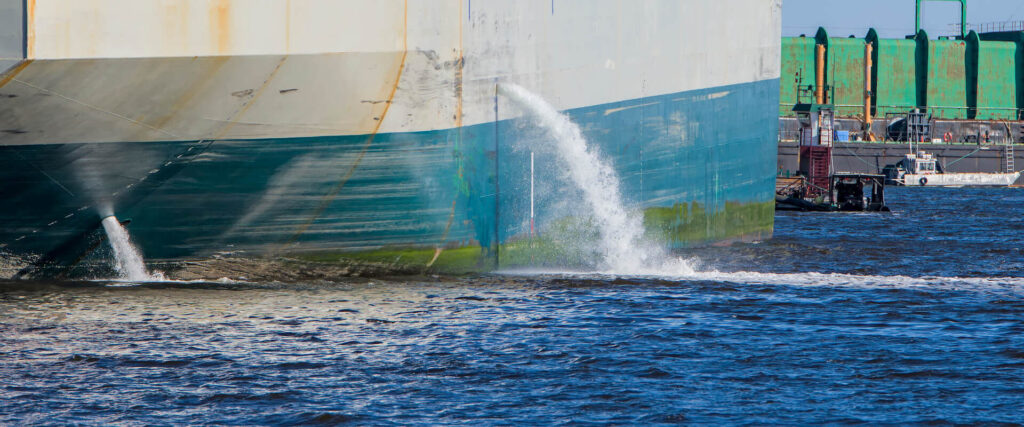
Ballast water management: stopping the spread of invasive species by ships
11 minute read.
Why commercial ships carry ballast water on board, and how it affects the marine environment.
Large cargo ships use ballast water to balance their weight and keep them stable during a voyage. Although it is essential for the safety of the ship, ballast water can be harmful to the marine environment as its discharge can release potentially invasive species into a new marine environment. Proper management and treatment of ballast water significantly reduces this risk.
What is ballast water?
Ballast is extra weight added to a ship when it unloads its cargo – without it, the ship would pop out of the water like a cork and could become unstable.
Prior to the 1880s, ships used solid ballast materials such as rocks and sand, which people had to shovel into and out of cargo holds. If not properly secured, solid ballast could shift in heavy seas, risking capsizing. With the introduction of steel-hulled ships and automatic pumping technologies in the 20 th century, water became a safer ballast material for ships.
When ships need ballast, water is easily pumped into ballast tanks from the sea or the inland waters where the ship is located, which adds weight to the bottom and sides of the vessel. Ballast water is pumped out into the ocean when it is no longer needed (when the weight of the ship needs to be lightened) – for example, when the ship is taking on cargo. Ballast water can be disposed of on land while ships are at berth; however, this practice is not common as it is costly and requires specialized equipment and complex processes.
Ballast tanks are an integral part of a ship’s design with their number and size varying according to the vessel’s type and construction. Ships can have a range of ballast capabilities and capacities, but generally ballast equates to 25% to 30% of the weight the ship can carry – including cargo, fuel, crew, passengers, food, and water – or its dead weight tonnage.
Why is ballast water important?
Ballast water is crucial for the safe operation of ships. It is used to adjust the distribution and overall weight of the vessel to keep the ship floating upright and in a safe, stable condition. Ballast is used to compensate for different cargo loads that a ship may carry at different times, including changes in weight during loading and unloading. It also provides stability and manoeuvrability during a ship’s voyage.
Ballasting – the process by which a commercial vessel pumps water in or out its ballast tanks while in transit or at a port – is essential for safety, especially if the ship is carrying a heavy load in one hold and a lighter load in another, or empty and facing rough seas. Ballasting is not to be confused with “bunkering” – the process by which a ship’s fuel tanks (called bunker tanks) are filled with the marine fuel (called bunker fuel ) needed for the voyage.
Why is ballast water an issue?
Loading and unloading untreated ballast water can pose a major threat to the environment, public health and the economy as ships become a carrier for the transfer and spread of threatening invasive aquatic species , from one part of the world’s oceans to another.
When ballast water is pumped into a ship, sediment and microscopic organisms are also transferred into the ballast tanks. These organisms include bacteria, microbes, small invertebrates, eggs, cysts, and larvae of various species. Many of these organisms are able to survive for extended periods in inhospitable environments, including a ship’s ballast tanks. When the ballast water is discharged, the organisms are released into the local marine environment. Without their natural predators and given the right conditions these foreign species will not only survive but can also flourish, becoming invasive and threatening and even eliminating resident populations.
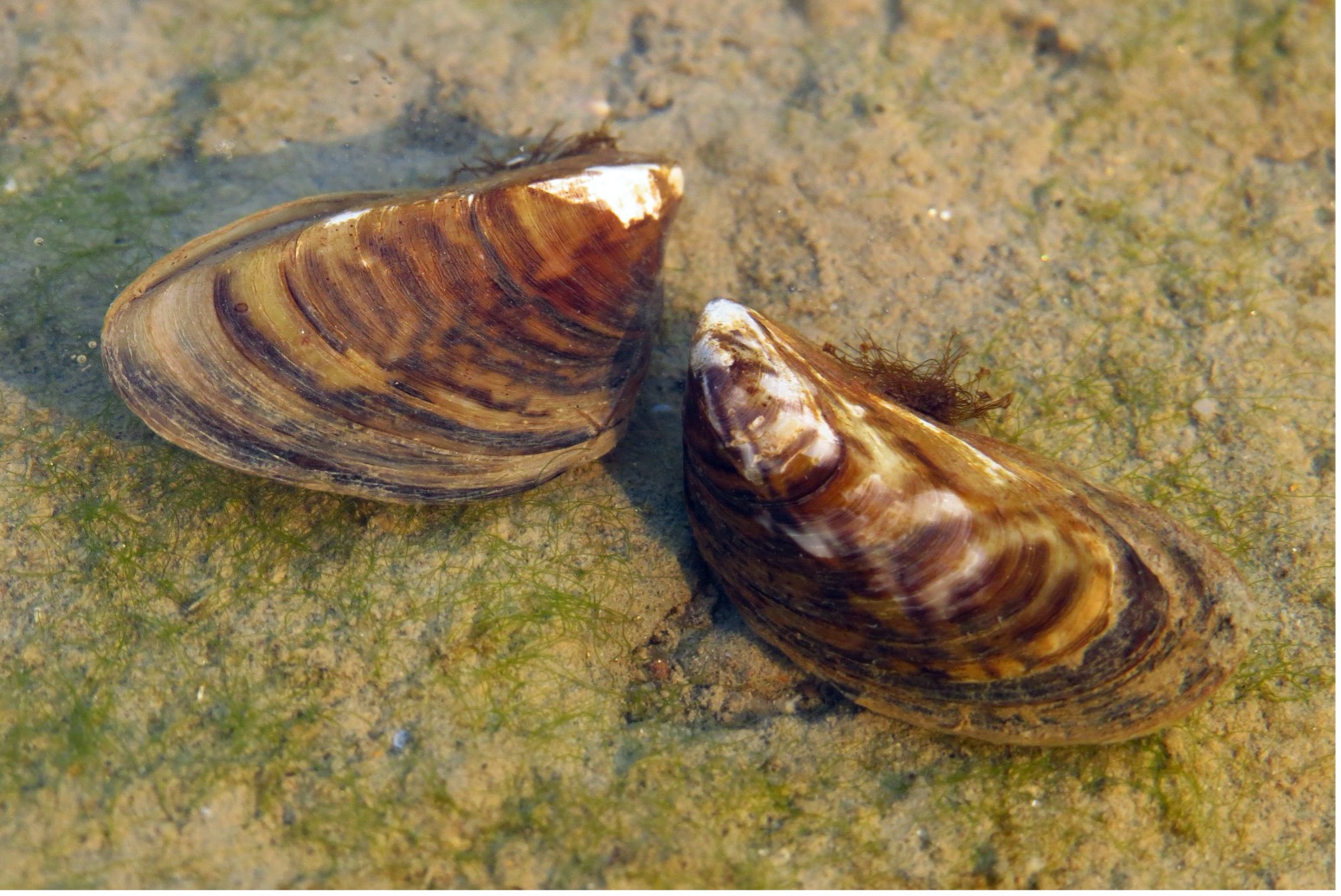
The zebra mussels’ invasion of the Great Lakes is one example of the devastation a species can cause when introduced to a new marine environment. Since its arrival in the late 1980s due to ship ballast water discharge, this freshwater mussel, native to the Black and Caspian Seas in Europe, has caused significant environmental damages, including disrupting the local food chain. Because they reproduce quickly and in large numbers – it is estimated that females can lay as many as one million eggs per year – zebra mussels rapidly overwhelm local species such as native mussels, feeding on the same food sources and hampering native species’ growth and development. Zebra mussels can also attach to and suffocate native mussels, causing them to die. Over the years, zebra mussels have continued to spread in Canadian waters and have been found in Quebec (St. Lawrence River) and Manitoba (Lake Winnipeg). This invader has also cost billions of dollars for cleaning and repairs to underwater infrastructure, for example clearing clogged outflow pipes and clusters on pilings.
On the economic front, the impact of invasive species is considerable. In Canada alone, it is estimated that invasive aquatic species cause close to $6 billion in disruption and damages every year. 1 These include increasing the proliferation of toxic algae, clogging water intakes and pipes for power and water treatment plants, and damaging watercraft and docks.
Ships’ ballast water is one of the main causes of the transfer of invasive aquatic species worldwide, explaining why it has become an important issue over the past decades. The spread of invasive species is now recognized as one of the greatest threats to the ecological and the economic well-being of the planet as the damage caused is often irreversible. 2 For example, the European Green Crab – one of the world’s most unwanted invasive species – was first introduced by ship to eastern Canada in the 1950s and, more recently, to the west coast of Vancouver Island in British Columbia. It is a formidable predator that out-competes native crabs for food and disrupts essential eelgrass beds and the crustaceans, molluscs, and fish they shelter. Because they compromise the overall balance of the coastal ecosystems and reduce the abundance of native species, European Green Crabs threaten local fisheries and aquacultures and the people that depend on them. 3 It has been found to threaten salmon including the food, ceremonial, and social fisheries of Indigenous communities. Although the population of European Green Crab is closely monitored and controlled in Canadian waters, this invasive species can cause critical damage to the marine environment in which it thrives.

Facts and figures about ballast water and invasive species: 4
- Approximately 10 billion tonnes of ballast water are transported worldwide every year, which could fill about 4 million Olympic-sized swimming pools
- An estimated 7,000 aquatic species are transferred in ballast water every hour of every day
- One new invasion occurs every 9 weeks
The European Green Crab, round goby, barnacles, and bloody red shrimp are all examples of invasive aquatic species found in Canadian waters. Learn more about the role commercial marine shipping plays in the transfer of invasive species here .
What are the ballast water regulations in place in Canada?
To prevent ecological and environmental damage resulting from the discharge of ballast water, in 2006 Canada implemented Ballast Water Control and Management Regulations (now Ballast Water Regulations ) under the Canada Shipping Act, 2001 .
In 2010, Canada acceded to the International Maritime Organization’s (IMO) International Convention for the Control and Management of Ships’ Ballast Water and Sediments , commonly known as the Ballast Water Management Convention. The Convention, which came into force in September 2017, aims to prevent the spread of harmful aquatic organisms from one region to another, by establishing standards and procedures for the management and control of ships’ ballast water and sediments.
The ballast water management standards under the Convention include:
- D-1 : a standard for ballast water exchange that requires ships to exchange their ballast water in open (at least 200 nautical miles from the shore) and deep seas (at least 200 metres deep), away from coastal waters 5
- D-2 : a standard that prescribes the maximum number of living organisms allowed to be discharged in ships’ ballast water. Ships must install onboard ballast water management systems to treat the ballast water before it is discharged
- D-3 : a standard for the approval of ballast water management systems to be used. In Canada, treatment systems meeting the IMO ballast water management systems code and approved by Transport Canada must be installed onboard commercial ships of 400 gross tonnes or more, such as bulk and car carriers, container ships and oil tankers
Commercial ships of at least 400 gross tonnes built on or after September 8, 2017, must be equipped with a ballast water management system. However, the vessels built before that date must be retrofitted with a ballast water management system by 2024 to meet the Ballast Water Management Convention’s D-2 standard. 6
In 2021, Canada adopted new Ballast Water Regulations to replace the previous regulations and impose more stringent requirements on ships while ensuring better compatibility between the Canadian and American ballast water regimes. 7 The new regulations apply to Canadian vessels everywhere and foreign vessels operating in Canadian waters that are designed and built to carry ballast water. Under these regulations, ships are required to:
- Develop and implement a ballast water management plan
- Obtain a certificate attesting that their ballast management plan meets the Convention’s requirements
- Keep records of ballast water regulations and be subject to inspections to verify compliance with the regulations
- Comply with a performance standard (D-2 of the Convention) to limit organisms discharged by 2024
Failure to comply with these regulations is subject to monetary penalties that can range from $600 to $25,000, depending on the violation. The new regulations allow smaller vessels – less than 50 m in length and 3,000 gross tonnes, that are not self-propelled – operating in Canadian waters and the high seas the option of adopting an equivalent compliance approach tailored to their operations rather than installing a ballast water management system. 8 More information on the new Ballast Water Regulations is available here .

What is a ballast water management plan?
The ballast water management plan is an operational tool ship operators must develop, implement, and keep on board to meet the Ballast Water Management Convention’s requirements. It outlines the actions to take and the procedures to follow by the ship’s crew to ensure the safe management of ballast water. The plan addresses the following:
- What are the duties of the crew in carrying out ballast operations
- How to conduct ballasting operations
- Where are locations for ballast water exchange
- What are the rules for different port state controls worldwide
- Which ports provide shore discharge facilities for sediments and ballast water
The plan also requires record-keeping – ballast water exchange record book – in which information such as the date and the amount of ballast water exchanged, the salinity and temperature of the ballast water, and the location of the ship, is recorded.
What are ballast water management systems?
Ballast water management systems eliminate the organisms that can be found in ships’ ballast water. These systems use or combine different technologies – filters, chemicals, light, ultrasound, heat, electricity, magnetic fields – depending on the type of ships, the space available onboard, and cost. Ballast water is generally treated in a two-stage process through which the solid particles in the water are first separated before the water is treated using one or more technologies to destroy potentially harmful marine organisms in the water or sediments.
Why is the requirement for ballast water management systems onboard ships causing controversy in the Great Lakes and St. Lawrence region?
Canadian ship operators have raised concerns over the use of ballast water management systems in the Great Lakes and St. Lawrence River. Both the effectiveness of the systems to treat freshwater to the level required by the Convention’s standard and the practicality, in terms of time and cost, are being questioned. Retrofitting a ship to install a ballast water treatment system can take several months and cost up to $3.5 million, 9 a significant impact to ship owners and operators’ budgets.
However, most of the controversy is due to Canada and the United States disagreeing on the requirement for ballast water management systems onboard ships in the Great Lakes. Unlike Canada, the U.S. has not ratified the Ballast Water Management Convention, and although it has implemented most of its provisions, it does not require its domestic fleet operating in the Great Lakes to install ballast water management systems. This decision is based on the premise that current systems are not well suited for the region’s unique environment and add additional costs for ship operators.
With the U.S. fleet of commercial vessels operating on the Great Lakes exempted from having to install and operate costly ballast water management systems, both the freshwater ecosystem and the competitiveness of Canadian ship operators’ is at risk. The countries are currently negotiating a resolution.
In light of Canada’s new Ballast Water Regulations, vessels operating in the Great Lakes built in or after 2009 will have until 2024 to comply with the performance standard and install a ballast water management system on board, while vessels built before 2009 will have until 2030 to come into compliance. American vessels operating in the Great Lakes will be exempt from having to install and use a ballast water management system as long as they don’t load or unload ballast water while transiting in Canadian waters.
Indigenous views:
Aquatic invasive species introduced through ships’ ballast water can have significant impacts on Indigenous communities across Canada. Healthy and balanced ecosystems are crucial for all living things. By competing with local marine life for resources, invasive species can jeopardize the health and population size of native species. Once an invasive species is introduced to a new area, it can be difficult to control and impossible to eradicate, causing irreparable harm to the local ecosystem. The disruptions invasive species cause in the marine environment can compromise its sustainability and that of the Indigenous communities who rely on it – including local seafood – to thrive and survive.
Invasive species can threaten the Indigenous way of living as Indigenous Peoples share a deep connection with nature, its biodiversity, wildlife, and waters. They have a long and historic relationship with the land that feeds them, treating it with care and respect. Many communities still harvest their food and medicine from the land. When invasive species disrupt the availability of native fish and shellfish they threaten the viability of local food sources and fisheries, which causes a significant impact in these communities.
As stewards of the land and water, Indigenous communities work to support the health of their environment and the many species it sustains. That includes protecting food sources and medicinal plants. Managing invasive species – and building capacity to do so within the communities – is an important pillar of Indigenous stewardship. Learn more about the role Indigenous communities can play in invasive species management in this toolkit developed by the Invasive Species Council of BC, in partnership with the Indigenous Invasive Species Network and Indigenous Services Canada.
Invasive Species and Marine Shipping
The Canadian Ballast Water Program
The Ballast Water Management Convention
Indigenous Community Toolkit for Managing Invasive Species
#clearfacts #sustainableshipping #invasivespecies
1 Fisheries and Oceans Canada. (2018). A Canadian Action Plan to Address the Threat of Aquatic Invasive Species . 2 Canadian Science Advisory Secretariat. (2014). National Risk Assessment for Introduction of Aquatic Nonindigenous Species to Canada by Ballast Water. Fisheries and Oceans Canada for Transport Canada. 3 Government of Canada. (2021). European Green Crab . 4 International Maritime Organization. (2019). Ballast water management – the control of harmful invasive species . 5 International Maritime Organization. (2019). Implementing the Ballast Water Management Convention – What are the ballast water management standards? 6 Regulation D-2 Ballast Water Performance Standard – Ships conducting ballast water management shall discharge less than 10 viable organisms per cubic metre greater than or equal to 50 micrometres in minimum dimension and less than 10 viable organisms per milliliter less than 50 micrometres in minimum dimension and greater than or equal to 10 micrometres in minimum dimension; and discharge of the indicator microbes shall not exceed the specified concentrations. 7 Government of Canada. (2019). Canada Gazette, Part II, Volume 155, Number 13: Ballast Water Regulations . 8 Government of Canada. (2019). Canada Gazette, Part II, Volume 155, Number 13: Ballast Water Regulations . 9 DNV Maritime Impact. (2019). Type-Approved, USCG-Compliant Ballast Water Treatment Systems Now Widely Available .
You may also be interested in
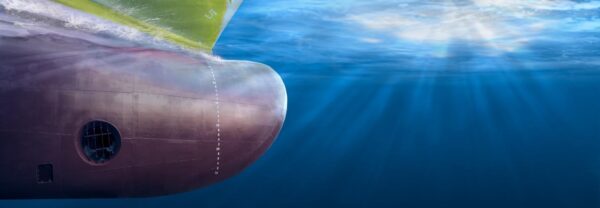
Anti-fouling paints: What are they and what effects do they have on the environment?

Beyond the Horizon: Shore-based Technology

Emergency Towing Vessels: Providing a Lifeline to Safety for Ships in Distress Around the World
- Ship Charter Rates
- Ship Bunker
- Chartering News
- Chartering Lessons

Voyage Estimation
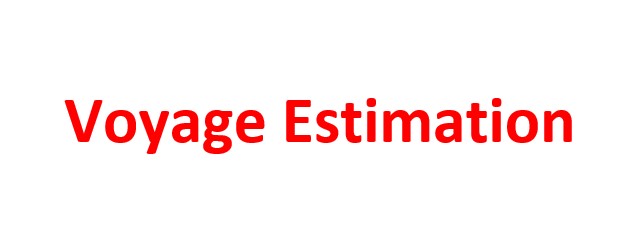
Ship Voyage Estimation is forecasting of costs and revenues. Unavoidably, Ship Voyage Estimation includes comparing one voyage with an alternative voyage to see which produces the most immeasurable yield. Ship Management or Shipbrokers are closely involved in Ship Voyage Estimation calculations. Ship Manager must be adequately aware of the process of voyage estimating. It is important to understand how numerous pieces of data, supplied by the ship manager, apply to the process of estimating the profitability of a proposed voyage.
Voyage Estimation incorporates both Voyage and Time Charter Trips (TCT). Time Charter Trips (TCT) are infrequently as straightforward as they seem. Ships do not run like clockwork, therefore, in Voyage Estimation, it is impracticable to calculate to perfection. Voyage Estimation aim should be less than absolute accuracy and it is vital to seek to achieve this and to test the accuracy of the Voyage Estimates against the Final Voyage Results.
For Voyage Estimation , it is also necessary to know maritime geography, distances of main ports, and load line zones. There are many digital distance tables, however, to avoid ridiculous mistakes shipbrokers should have a reasonably accurate idea of the major world distances. A helpful method is to divide the world into regions, generally this principally falls into oceans, and then learn several strategic distances across each region.
Preferably, instead of actual distance, a shipbroker can think in terms of days steamed. For example, a speed of 14 knots works out at approximately 3 days per 1,000 nautical miles. Therefore, it is easy to remember that a transatlantic voyage from US Gulf to the Netherlands is performed in 15 days. Under this easy method, voyages can be calculated and remembered. After calculating the length of the sea voyage, a frame can be produced for Voyage Estimation.
Ship Voyage Length
Ship voyage should always be from the time and the place where the ship completes discharge of the previous cargo. Therefore, the first part of the voyage is the Ballast Leg unless the shipowner is fortunate enough to secure a cargo out of the port in which the ship has just discharged.
Some shipbrokers and ship managers commence the voyage at the loading port and follow the laden passage with a theoretical ballast back to the loading port again. However, while this view might be realistic for tankers, dry cargo tramp ships rarely proceed on the same voyage twice so this is rarely a practical solution. With distances to hand, it is not challenging to estimate the length of the sea passage including the Ballast Leg. Estimating the time spent in port can be a more prominent problem.
Estimating the time spent in port for tankers is moderately simple as most tanker charter-parties incorporate a standard 72 hours all purposes laytime. However, the time spent in port for dry cargo bulk carriers differs enormously. The difficulty is that a shipbroker or ship manager cannot usually calculate the port time until they know the cargo quantity. A shipbroker or ship manager cannot calculate the cargo lift until they know the bunkers which they cannot work out until they know the port time. Dry cargo ships consume little bunkers in port which can be safely neglected for initial cargo estimates.
A shipbroker or ship manager should be very careful over the voyage route selected. Sometimes there are alternative routes and only a negligible difference will tilt the pendulum in favor of one or the other. A shipbroker or ship manager should consider bad weather, high canal tolls on one route, and cheaper bunkers on another. In Voyage Estimation, ship speed is another crucial factor. In some circumstances, it might be more beneficial to steam slowly and economize on bunkers.
Cargo Quantity
A shipbroker or ship manager needs to know the ship’s total deadweight (DWT). From the ship’s total deadweight (DWT), a shipbroker or ship manager must first deduct the constants (stores, water, lubricants, spares, the weight of the crew). Total constants weight is rarely critical. Total constants weight is in the region of 400 to 500 metric tons for most deep-sea ships of 30,000 DWT and above. Moreover, a shipbroker or ship manager needs to deduct the bunkers on board to calculate the true cargo capacity DWCC (Deadweight Cargo Capacity). A proper figure for DWCC (Deadweight Cargo Capacity) is calculated, however, this is not the end of the Voyage Estimation .
The ship may be able to lift a particular tonnage of cargo but also the ship must have enough space to carry that cargo. Therefore, a shipbroker or ship manager must also calculate the Stowage Factor (SF) . Theoretically, by dividing the grain or bale cubic of the ship by the Stowage Factor (SF), a shipbroker or ship manager calculates the ship’s volume capacity. However, if there are various types of grades of cargo to be separated, it may be impossible even to fill the ship. Furthermore, ship trim and stability must also be considered.
A shipbroker or ship manager must also consider the load-line zones and calculate the cargo accordingly. All load-line zones transited between loading and discharging ports must be considered. For instance, a ship cannot enter a winter zone when loaded to summer marks.
When the cargo quantity, loading rates, and discharging rates per day are known, then the port time can be estimated with some accuracy. However, there are some pitfalls because it is rare for weekends and holidays to count in dry cargo charter-parties and these, united with notice time and weather delays, extend the port time before demurrage is likely to commence. Example:
A bulk carrier is to load 49,000 metric tonnes of cargo and the charter loading rate is 3,500 tonnes (PWWD) per weather working day of 24 consecutive hours, Sundays and Holidays Excepted (SHEX). If a shipbroker or ship manager divides 49,000 by 3,500, the loading time allowed to the charterers is 14 days. However, 14 days excludes weekends and if you consider the working week to be 5 days, the laytime allowed approaches 3 weeks. If allowances are also made for notice time and some weather delays, it will become realistic to allow 20 days in port for loading operation. If loading operation is to take place throughout extensive Public Holidays (Christmas, New Year, Ramadam), even more port time should be allowed. If the time allowed includes Sundays and Holidays (SHINC) less allowance will be needed, in this example, approximately 15 days. Even with Sundays and Holidays (SHINC), there are unavoidable delays such as shifting, notice time, etc.
Generally, the full-time allowance should be put in the Voyage Estimation and demurrage/despatch should be ignored. Furthermore, different criteria have to be used for Despatch Charters for particular trades such as sugar. It is very well-known that ships habitually load and discharge completely within their laytime and, however, shippers and receivers expect to earn considerable despatch money. Therefore, when comparing two voyages, Despatch Charters will present an abnormal disparity. Unfortunately, there is no shortcut to knowledge in such cases, and a shipbroker or ship manager must be aware of the trades where fast turn-rounds are to be found. In Despatch Charters, a shipbroker or ship manager should estimate a lesser port time than allowed. Therefore, a decent addition to the expenses must be made to cover the inevitable despatch money.
In Voyage Estimation , if more than one port of loading and/or discharging is used, extra hours must be allocated for the time required in the actual process of entering and leaving.
Other Delays in Voyage Estimation
Bunker : in some ports, bunkering might be lengthy. In Voyage Estimation, a shipbroker or ship manager should allocate one (1) day for each bunkering call.
Canal Transit : canal transits unavoidably lengthens the voyage, therefore, a shipbroker or ship manager should allocate two (2) days each for passage through Suez Canal and Panama Canal in Voyage Estimation. Time might be lost for waiting and for the canal transit.
Bad Weather : usually a shipbroker or ship manager does not allow additional steaming time for possible bad weather unless it is certain from the nature of the voyage that delay will be experienced.
Starting the Voyage Estimation
When the main components are available, a shipbroker or ship manager can begin the Voyage Estimation calculations. Broadly, the Voyage Estimation calculation consists of income minus expenditure. Voyage Estimation form and procedure used is a matter of personal opinion however these can all be classified under one method. Most shipping companies have their Voyage Estimation layout depending on the type of ship they manage.
It is extremely easy to reduce the Voyage Estimation on a piece of paper, indeed. However, before that level is reached, significant experience has to be gained at a more leisurely pace and this is where a set format is so essential. In Voyage Estimation, if all the different items of income and expenditure are set out, it is hard to forget the odd item, which can make the difference between profit and loss. If a shipbroker or ship manager is likely to be involved in regular Voyage Estimation, he drafts out a suitable form and uses the Voyage Estimation draft constantly.
Today, there are computer programs for Voyage Estimation such as Netpas Estimator , however mastering the manual Voyage Estimation method is essential to avoid silly errors with the computer.
Voyage Estimation can be made appropriately on plain paper; the essential point is to learn the method. Generally, a shipbroker or ship manager follows the here below Voyage Estimation method:
1- A shipbroker or ship manager preplans the voyage, duration, and bunker consumption. Preplanning enables a shipbroker or ship manager to observe at a glance just what is intended. This is called an itinerary.
2- A shipbroker or ship manager calculates what cargo can be loaded. This part needs to be completed in conjunction with the itinerary. For instance, when port time is estimated against a daily loading or discharging rate.
3- A shipbroker or ship manager records all expenses such as bunkers, port disbursements, canal costs, stevedoring, despatch, extra insurance premium are obvious examples.
4- A shipbroker or ship manager assess Income, Profit, and Loss.
In the Voyage Estimation process here above, in part three (3), bunker consumption is presumably the most difficult to calculate. Ship Bunkering is an art and no two voyages are likely to be the same, due to seasonal changes, price fluctuation, and the need to balance bunker prices against freight income.
When transiting a canal or a narrow waterway a ship may run on MGO (Marine Gas Oil) in the main engine although this is becoming less common with modern engine designs. MGO (Marine Gas Oil) is of a higher quality and more expensive than IFO (Intermediate Fuel Oil). MGO (Marine Gas Oil) usage result in a more instant engine response to navigation movements. During MGO (Marine Gas Oil) usage, ordinary daily speeds and consumptions do not apply. The ship steams slowly and consumes bunkers more economically. Therefore, it might be necessary to estimate normal speed and consumption to and from either end of the canal, adjusting time and consumption appropriately.
Port costs cannot easily be estimated without experience and most shipping companies keep records of previous port calls. Organizations such as BIMCO (The Baltic and International Maritime Organization) and INTERTANKO (International Association of Independent Tanker Owners) contribute important information on many ports but presumably the most accurate way is to call the port agent in question with necessary details of the ship and ask the port agent to provide a Proforma Disbursement Account (PDA). Normally, canal dues are based on the ship’s Canal Tonnage as the canal authorities tend to add in more cubic earning spaces when they grant the ship a canal certificate. A shipbroker or ship manager should keep in mind that mere calculation of the canal dues payable will not be sufficient, as extra charges yield for such items as agency and towage.
In the Voyage Estimation process , there is the possible expense of despatch payable if the trade is such that the ship is turned around much faster than the laytime allows. If a shipbroker or ship manager is in any doubt, it is more beneficial to allow full time in the Voyage Estimation to calculate the most pessimistic result and be on the safe side.
In the Voyage Estimation process , a shipbroker or ship manager should also include cargo-handling expenses and extra insurance premiums such as breaching INL (Institute Navigating Limits) or extra WRI (War Risk Insurance) for trading to regions beset by the risk of warlike action.
A shipbroker or ship manager should calculate the cargo intake and multiply this quantity by the rate of freight offered by charterers. The sum is known as the Gross Freight, from which have to be deducted any Shipbrokers’ Commissions due. Besides, it is common to deduct any Freight Tax at this stage. Freight Tax and ILW (In Lieu of Weighing) are being almost invariably a percentage of the Freight. The result after deducting these items from Gross Freight is called Net Freight.
The Voyage Estimatio n result can be calculated by subtracting expenses from income and dividing the result by the number of days taken for the voyage. The result is the Gross Daily Profit. Gross Daily Profit gives us an easily comparable amount for any variety of different voyages. To calculate the Net Daily Profit, it is essential to include the Daily Running Costs. A shipbroker or ship manager is not concerned as to how that daily figure is made up but will simply want a lumpsum per day. It is the choice of the shipowner whether or not the capital costs are included in this figure however, whether capital costs are included or not, it is important to be consistent.
Tankers Voyage Estimation
There are a few dissimilarities between Voyage Estimation for dry cargo ships and tankers. Tanker charters based upon Worldscale , the laytime calculation is easier as the scale allows for 72 running hours total for loading and discharging and 96 hours total in port. An expense in tankers that do not occur in dry cargo ships is the consumption of bunkers for ancillary purposes such as cargo heating, pumping cargo, and tank cleaning.
It is exceptionally challenging to estimate bunker consumption for heating cargo depending, as it does, on the temperature at which the cargo is loaded, whether in wing or center tanks, and on the ambient temperature of the sea and air during the voyage. Only the technical department can give an accurate estimation for this purpose as, without their available statistics, it can only be pure guesswork. Pumping and tank cleaning is simpler, however the technical department should be asked for an average bunker consumption based on experience.
Time Charter Voyage Estimation
When charterers take ships on time charter for trips, it is apparent that charterers want to estimate the daily profit on Time Charter Trip (TCT) in the same way as a Voyage Charter to compare the two results. Usually, Charterers prefer to take a ship on Time Charter (TC), either for a Trip or Period, as it gives charterers flexibility and also the possibility of diminishing their costs.
Time Charter (TC) Voyage Estimation would be an extremely simpler operation if the ship is taken on delivery at the previous discharge port and redelivered on completion of the voyage in question. Shipowner or ship operator simply deduct the Daily Running Cost from the Hire earned per day to achieve the daily profit. Commission should be deducted to achieve the daily net profit. If there is any difference between the charter price of bunkers paid by charterers on delivery and the actual price paid by shipowners, this must similarly be taken into account in the calculations. In Time Charter (TC) Voyage Estimation, problems arise when the ship is not taken on hire immediately after the previous employment and allowance has then to be made, not only for the time lost to shipowners whilst the ship is unemployed, but also for the bunkers consumed during that period. The calculation is not challenging if the income and expenditure and the number of days for the entire voyage are considered. By grossing up the daily hire receivable for every day the ship is likely to be on charter and deducting the Daily Running Cost, the shipowner obtain the profit for the entire operation. Daily Running Cost must be charged not only for the trip period but also for the ballast or waiting time before hire commences plus any bunkers, port charges, canal dues, etc. which are incurred by the shipowners before commencement of hire. To calculate the daily profit it is then necessary to divide by the number of days involved which will include those days ballasting or waiting before ship delivery, not just the days the ship is on hire. By this method, the shipowner obtains a comparable number to be set against other Voyage Estimations.
If several Voyage Estimations show similar results, it is up to the shipowner to decide whether he prefers a short or long voyage. The decision may depend on the shipowner’s expectations of the future increase or decrease of the shipping market and also depending on which region the shipowner prefers to complete the voyage for future trading. Sometimes, a shipowner may prefer a voyage with a lower return if it positions the ship ideally for a subsequent voyage or drydocking.
Voyage Estimation Example
In Voyage Estimation Example here below, a shipowner compares two (2) Voyage Estimations for his ship called MV HANDYBULK YAGMUR and selects the most profitable voyage. The question is presented here below provides all the data required to make the Voyage Estimation calculations. However, we simplified the problem that would normally arise in practice, where a shipbroker or ship manager would have to search all the data such as distances, and cheapest bunkers available.
A shipowner has the following vessel available in April at Pemba (Mozambique) following discharge of a cargo:
MV HANDYBULK YAGMUR 2021 Built Cyprus Flag Lloyd’s Register (LR) 15,240 SDWT (Summer Deadweight Tonnage) 8.86 meters Summer Saltwater Draft 5 Holds/5 Weatherdeck Hatches Flush Tweendecks No 1,2,3 & 4 Bridge & Engines 4/5ths aft. No. 5 a single hold, floored over Derricks: 1 x 50, 4 x 10, 6 x 5 tonnes SWL Bale: 19,520 cbm (689,350 cft) Grain: 21,295 cbm (752,030 cft) LOA: 141 m Beam: 20.45 m Constant Weights: 150 tonnes Speed/Consumption At Sea: 13 knots 18 mtons VLSFO + 1.5 mtons MGO Port Idle: 1.5 mtons MGO per day Port Working: 2.5 mtons MGO per day VLSFO (Very Low Sulphur Fuel Oil) MGO (Marine Gas Oil)
Bunkers Remaining on Board (ROB) 300 mtons VLSFO and 40 mtons MGO MV HANDYBULK YAGMUR carries a Safety Surplus of 50 mtons VLSFO and 15 mtons MGO at all times. These quantities to be allowed for in any cargo quantity calculation (DWCC) but not to be costed in voyage results.
The Shipowner is analyzing offering for the following cargo: A/C Minerals Ltd Full Cargo Bulk Minerals Loading Port: 1 sb 1 sp Mauritius Discharging Port: 1 sb London Loading Rate: 1,500 mtons PWWD SHEX Discharging Rate: 750 mtons PWWD SHEX Freight USD14.00 per mtons Demurrage USD 2,150 /Half Despatch Laytime Saved Bends 5.5% Total Commission including (3.75% Address Commission)
A shipbroker or ship manager knows from previous experience: 1- Actual loading takes approximately 2 days, therefore allow for payment of despatch in the Voyage Estimation. 2- London is usually a congested port, therefore allow full laytime for discharge.
For Voyage Estimation: a- Mauritius/London via Suez Canal b- Mauritius/London via Cape of Good Hope (bunkering at Durban)
You will require the following information: 1- Distances: Pemba/Dar Es Salaam 475 nm (nautical miles) Dar Es Salaam/Durban 1550 nm (nautical miles) Dar Es Salaam/Suez 3650 nm (nautical miles) Durban/London 6850 nm (nautical miles) Suez/London 3200 nm (nautical miles)
2- Suez Canal Transit Allow 2 days to Bunker and transit the Suez Canal consuming: 7 mtons VLSFO 7 mtons MGO.
3- Bunker Prices (USD/pmt) VLSFO MGO Remaining on Board (ROB) 70 145 Suez 85 180 Durban 85 325
4- Port Disbursements (USD) Dar Es Salaam 17,500 Durban 2,500 Suez Canal 35,000 London 45,000
Routing via the Suez Canal:
MV HANDYBULK YAGMUR is anticipated to steam around 312 miles per day at sea (13 x 24 hours) weather permitting. Usually, percentages of days at sea are best rounded up to whole days for simplicity of calculation and to allow for any unexpected delays. However, in short voyage estimations, this is not realistic. Therefore, for the 475 nm (nautical miles) between Pemba (Mozambique) and Dar Es Salaam 1.5 days should be allowed (475/312 = 1.522) although this percentage can be disposed of in the final voyage days analysis by allowing a compensating 2.5 days to load in Dar Es Salaam. Dar Es Salaam to the Suez Canal is 3,650 nm (nautical miles) which, divided by 312 miles per day equals around 12 days. 2 days is allowed for the Suez Canal transit and a canal bunker consumption of 7 mtons VLSFO and 7 mtons MGO, these items can be entered. The final leg of 3,200 nm (nautical miles) from the Suez Canal to London should take about 10 steaming days.
We are going to calculate the port time in London however, since we are to work on a daily discharge rate in London and allow full laytime. So, we calculate the quantity of cargo on board. Furthermore, we should consider Load-Line Zones and any port limitations en route. Luckily, MV HANDYBULK YAGMUR will be in summer zones throughout the voyage so that this exercise does not have to assume the discussion of Load-Line Zones which will be dealt with in a later lesson. Fully laden MV HANDYBULK YAGMUR’s draft is still within the limits of the Suez Canal and there is sufficient depth of water at both loading and discharging ports. As a result, no restricting factors are altering the quantity of cargo to be loaded apart from those of the ship itself, its cubic capacity, and deadweight. Bulk minerals stow around 1.13 to 1.22 cubic meters per tonne (40 to 43 cubic feet).
Allowing for an increase to this calculation for loss of trimming spaces, as a result of tween-deck overhangs, of an extra 10% as compared with a bulk carrier, the cubic space available should still be more than adequate. 21,295 cubic metres divided by 1.34 (1.22 + 10%) = 15,900 mtons approximately. Consequently, cargo intake can be based on the maximum DWT (Deadweight) available on sailing from Dar Es Salaam. In other words, up to summer marks less constant weights and bunkers. Constant weights are known. Bunkers need to be calculated. T
he longest voyage leg is that from Dar Es Salaam to the Suez Canal (12 days) and therefore we estimate that the MV HANDYBULK YAGMUR will have maximum bunkers on board at the commencement of the voyage. MV HANDYBULK YAGMUR has 300 mtons VLSFO and 40 mtons MGO ROB (remaining on Board) when sailing from Pemba (Mozambique). Therefore, from the MV HANDYBULK YAGMUR’s summer deadweight (SDWT) must be deducted an allowance for bunkers and constant weights calculated to remain on board when sailing from Pemba (Mozambique) to that stage of the voyage. Therefore:
Summer Deadweight (SDWT) 15,240 mtons Less VLSFO 300 – 27= 273 mtons MGO 40 – 6= 34 mtons (2 mtons MGO at Sea + 4 mtons MGO at Port) Constant Weights= 150 mtons Estimated Cargo Intake (DWCC)=14,783
300 mtons VLSFO and 40 mtons MGO includes the allowance for Safety Surplus. Bulk cargo is loaded mechanically at Dar Es Salaam by shore equipment. Hence, the MV HANDYBULK YAGMUR’s port consumption will not be increased to 2.5 mtons daily, which would be the case if MV HANDYBULK YAGMUR’s cranes were used. Discharging at London will also be by shore equipment, the HANDYBULK YAGMUR’s cranes will remain idle. To find the total discharge duration in London, Estimated Cargo Intake (DWCC)=14,783 is divided by daily discharge rate of 750 mtons equals to 20 days (19.7 days).
However, discharge takes place on SHEX (Sundays Holidays Excluded) terms, therefore, build in time lost for weekends and holidays. A magic number that can be used in normal circumstances is the Factor of 1.4, which is 2 days lost for every 5 worked, a number that provides an estimate for SHEX (Sundays Holidays Excluded) terms. 20 days x 1.4 = 28 days on full laytime at London.
We have completed the Voyage Itinerary , Bunker Consumption , and Cargo Calculation of the Voyage Estimation . Now, we are going to calculate and combine all voyage expenses. We start calculating the Bunker Costs:
MV HANDYBULK YAGMUR has on board 300 mtons VLSFO and 40 mtons MGO at the commencement of the voyage, VLSFO cost at USD 70 and MGO cost USD 45 per tonne. The bunker balance required 130 mtons VLSFO and 48 mtons MGO must be taken at Suez and the cost should be added accordingly. The estimated disbursements (Port DAs) at Dar Es Salaam, Suez Canal, and London should be entered into Voyage Estimation. Now, we are going to estimate the Despatch Money. To calculate Despatch Money, we should take the estimated cargo of 14,783 mtons and divide it by the loading rate of 1,500 tonnes daily which is approximately 10 days. Loading will take approximately 2 days, and this can be deducted, to leave 8 days.
If the MV HANDYBULK YAGMUR arrives and loads in midweek, then this will be the number on which to base despatch. If loading takes place over a weekend, time loading might not count (if SHEX EIU). Furthermore, we should consider if the despatch is to be calculated based on All-Time Saved or on Working Time Saved. In this Voyage Estimation example, we are going to use Working Time Saved, and allow 8 days for despatch at Dar Es Salaam. Despatch Money can be calculated as:
Despatch Money equals half of Demurrage Rate (USD 2,150)= USD 1,025 Despatch $1,025 x 8 days= USD 8,200
We are going to calculate the income and the estimated result. The freight rate is USD 21 per tonne. Therefore, 14,783 mtons x $21 per tonne less 5.5% total commission leaves us with a net freight of USD 293,369. From this must be deducted the total expenses of USD 156,886, leaving a Gross Voyage Surplus of USD 136,483.
Gross Voyage Surplus of USD 136,483 is then divided by the estimated number of days required to perform the voyage and we have a return of USD 2,437 gross daily which is before the deducting of daily ship running costs. If ship daily running costs were given, we deduct daily running costs from the gross daily income to arrive at the net daily income.
Routing via the Cape of Good Hope:
We have already calculated Pemba (Mozambique) to Dar Es Salaam and port time there. We have already calculated the distances from Dar Es Salaam to Durban and from Durban, via the Cape of Good Hope, to London, and can base time and consumption on this data. We are going to estimate the port time in London. Therefore, we are going to calculate cargo intake. The sea distance from Durban to London is approximately 22 days at 13 knots, weather permitting. Therefore, bunkers remaining on board (ROB) at the beginning of this leg will be greater than for any other leg and will consequently affect the maximum cargo quantity which can be allowed on board at that point. Thus, although MV HANDYBULK YAGMUR can load more cargo than would be required at Dar Es Salaam, we should remember always that the ship’s summer freeboard must not be submerged at any stage of the journey.
If MV HANDYBULK YAGMUR is loaded to her full marks at Dar Es Salaam she would be overloaded when taking on necessary bunkers at Durban. Consequently, Durban sailing on summer marks is the restricting factor in this part of the estimate. Durban is located in a permanent summer load-line zone. Since the ship would then steam to London in either summer or tropical zones, there are no restricting factors of this nature. So, we can estimate the cargo intake:
Summer Deadweight: 15,240 mtons Less: Durban/London 396 mtons VLSFO Safety Surplus 75 mtons VLSFO Durban/London 33 mtons MGO Safety Surplus 15 mtons MGO Constant Weights= 150 mtons Estimated Cargo Intake (DWCC)=14,571
Therefore, Estimated Cargo Intake (DWCC) via the Cape of Good Hope is going to be less than steaming via the Suez Canal, but the difference is marginal and will not affect the time needed to discharge on full laytime in London:
14,571 mtons / 750 mtons daily discharge rate x 1.4 = 27.20 days approximately 28 days
Routing via the Cape of Good Hope, port and transit expenses are similar to the routing via the Suez Canal, except that Suez Canal tolls are avoided however, instead, Durban port costs are included. Despatch Money is also similar, the difference in the cargo loaded making only minor effect.
The extra steaming time is reflected in extra bunker consumption. Once again the 300 mtons VLSFO and 40 mtons MGO remaining on board (ROB) at the commencement of the voyage must be costed at USD 70 and USD 145 per tonne respectively. However, we should add the balance of VLSFO and MGO required to steam London at the Durban prices of USD 85 and USD 325 respectively. Therefore, the estimated total expenses for routing via the Cape of Good Hope is USD 138,726. The smaller cargo intake indicates a marginally lower income of USD 289,162, however, lower-income is offset by these reduced cargo expenses to leave an increased Gross Voyage Surplus of USD 150,436.
However, routing via the Cape of Good Hope takes longer than the route via the Suez Canal. Nonetheless, the net result is more profitably via the Cape of Good Hope by an increase of around USD 100 per day. Routing via the Cape of Good Hope generates a Gross Daily Income of $150,435/59 = $2,550 against routing via the Suez Canal generates a Gross Daily Income of $2437.
Voyage Estimation Time Charter Example
Let us assume that MV HANDYBULK YAGMUR is proposed a Time Charter business as follows:
Delivery APS Durban Time Charter Trip (TCT) via safe ports South and East Africa with Minerals. Redelivery DOP Izmir Duration about 60 days, without guarantee 5% Total Commission Charterer’s Hire Idea Maximum $3,000 per day
If the MV HANDYBULK YAGMUR performs this voyage, the shipowner would probably need to ballast after Izmir to the London-Continent to seek the next cargo. We are going to calculate if this time charter alternative is a better proposition than the voyage
Pemba (Mozambique)/Durban 1,350 nm (nautical miles) Izmir/London 2,775 nm (nautical miles)
In Voyage Estimation Time Charter Calculation , we should calculate the Gross Daily Return, so that fair comparison can be made with a voyage charter alternative, as well as other Time Charter Trips (TCT). In Voyage Estimation Time Charter calculation, brokerages and commissions must be deducted. Allowances have to be made where necessary for time and voyage expenses incurred from the start point of the exercise through to the start of the time charter, and again, from the completion of the time charter through to the end of the estimated voyage.
MV HANDYBULK YAGMUR will be open at Pemba (Mozambique) where she can proceed either to Dar Es Salaam to load minerals, or ballast to Durban to deliver on to Time Charter. The mineral cargo is going to be discharged in London and, for a tween-decker, the shipowner will certainly try to fix outwards from the Continent. However, the Mediterranean market is normally weaker for tween-deckers than is the Continent market. If we fix the Time Charter Trip (TCT) from Durban to Izmir, the shipowner will presumably ballast from Izmir to the Continent which must be considered. Therefore, we have another adjustment to perform following redelivery in Izmir. Pemba (Mozambique) to Durban and, at 13 knots, takes 4.5 days (1350/ 312). The distance from Izmir to London is 2775 nm (nautical miles) equating to a steaming distance of 9 days. Therefore, a total extra steaming of 13.5 days. We are going to calculate the approximate duration of the Time Charter Trip (TCT):
Income: USD 3,000 less 5% commission x 60 days= USD 171,000 Expenses: VLSFO 13.5 days x 18 (tonnes daily) x USD 70 per tonne = USD 17,010 MGO 13.5 days x 1.5 (tonnes daily) x USD 145 per tonne = USD 2,937 Total Expenses: USD 19,947 Income USD 171,000 less Expenses USD 19,947 = USD 151,053 USD 151,053/ 73.5 total days overall (60 + 13.5) = USD 2,055 daily
The Time Charter Trip alternative is not a better proposition than the voyage.
What is Ship Voyage Estimation?
Voyage Estimation is the calculation of the profit or loss that a ship will make from a proposed voyage charter. Voyage Estimation is simply profit and loss calculation for the particular voyage in question that is arrived at by deducting all related expenses from total income.
In voyage charter, there are two (2) types of costs:
- Operating Costs : crew costs, repairs and maintenance, insurance, stores, lubes etc.
- Voyage Costs : bunker (fuel), port dues, dock dues, canal tolls etc.
In voyage charter, operating and voyage costs are paid for by the shipowner. Therefore, Voyage Estimation must take into account freight income and subtract all voyage-related expenses, including address commission and brokerage.
In voyage chartering negotiations, Voyage Estimation is an indispensable part that assists shipowners to assess the financial feasibility of a particular trip vis-a-vis alternative voyages that may be available and in relation to the amount of profit required as well as prevailing competing freight rates.
On the other hand, Voyage Estimation is used by charterers in order to evaluate the appropriate ship for an attempt to minimize the cost of the transportation services.
Alternative voyages may be offered to shipowner and each alternative needs to be estimated prior to negotiating and completing any chartering deal. Voyage Estimation must be performed as accurately as possible. Even tough, Voyage Estimation is an estimate, it gives a very good indication for the potential profitability of a particular voyage. Furthermore, Voyage Estimation may provide comparisons with a Time Charter Equivalent (TCE) charter. Time Charter Equivalent (TCE) estimate is a figure that denotes the daily hire that the ship will obtain if chartered on the particular voyage trip.
Process of Voyage Estimation : Voyage estimating is a process that takes into account the following factors:
- Cargo and Stowage Factor
- Ship Characteristics
- Time at Sea
- Time at Port (Loading and Discharging Operations)
- Time at Bunkering Port
- Bunker (Fuel) Costs
- Canal Costs
- Freight Income
- Operating Expenses
- Commissions (Address Commissions and Brokerages)
- TCE (Time Charter Equivalent)
Best Voyage Estimation Software
Voyage Estimation Software, we recommend Netpas Estimator which is Powerful Voyage Estimation Calculator. Netpas Estimator is an outstanding and practical voyage calculator for tramper business sector. Netpas Estimator is an excellent voyage estimation software for most of the major types of tramper business such as Voyage, Cargo Relet and Time Charter. Netpas Estimator delivers practical voyage calculations and simulations to assist your Voyage Estimation straightforward and quick.
Shipbrokers can assist charterers anywhere and anytime with precise information. With Netpas Estimator , Shipbrokers can simply create Voyage Estimation and save it on the computer. Shipbrokers can open the saved Voyage Estimation and find the information quickly. Furthermore, Netpas Estimator delivers useful function such as Estimation Analysis, Loadable Quantity, Freight Simulator, and many additional functions. For more information please check www.netpas.net
HEADQUARTERS
HandyBulk LLC Oceania Business Plaza Tower 2000 Street Punta Colon 43th Floor Panama City, Panama
Contact Form
Dry cargo operations, what is laytime, ship cargo documents.

World’s First Offshore Floating Wind Turbine Component Exchange Completed At Kincardine Wind Farm

Russian Missile Attack Damages Odesa Port And Antigua-Flagged Vessel

Cargo Ship Owner & Operator Sued by Families Of Victims In Baltimore Bridge Collapse

U.S. Navy Partners With South Korea’s Hanwha To Strengthen Its Shipbuilding Capabilities

A Guide To Ballast Tanks On Ships
During the designing and construction stages of a ship , the ballast tanks are introduced at various locations for maintaining the stability of the ship during the sea voyage.
The concept of ballast is not new and has been followed since ancient times. In the earlier times, the sea-going vessels used solid ballast such as sandbags, rocks, iron blocks, etc. which were loaded/unloaded once the cargo loading or discharge operation was finished. This method helped to a certain extent to maintain the stability of the ship and its seaworthiness.
However, today’s vessels carry liquid ballast , which includes fresh water, salt water or brackish water in various ballast tanks. As ships get bigger in size and the cargo carried by the vessels varies one port to another (due to global economics, ship condition, local voyage requirements etc.), water ballast tanks are used to compensate for maintaining the trim and stability of the vessel for a safe sea passage.
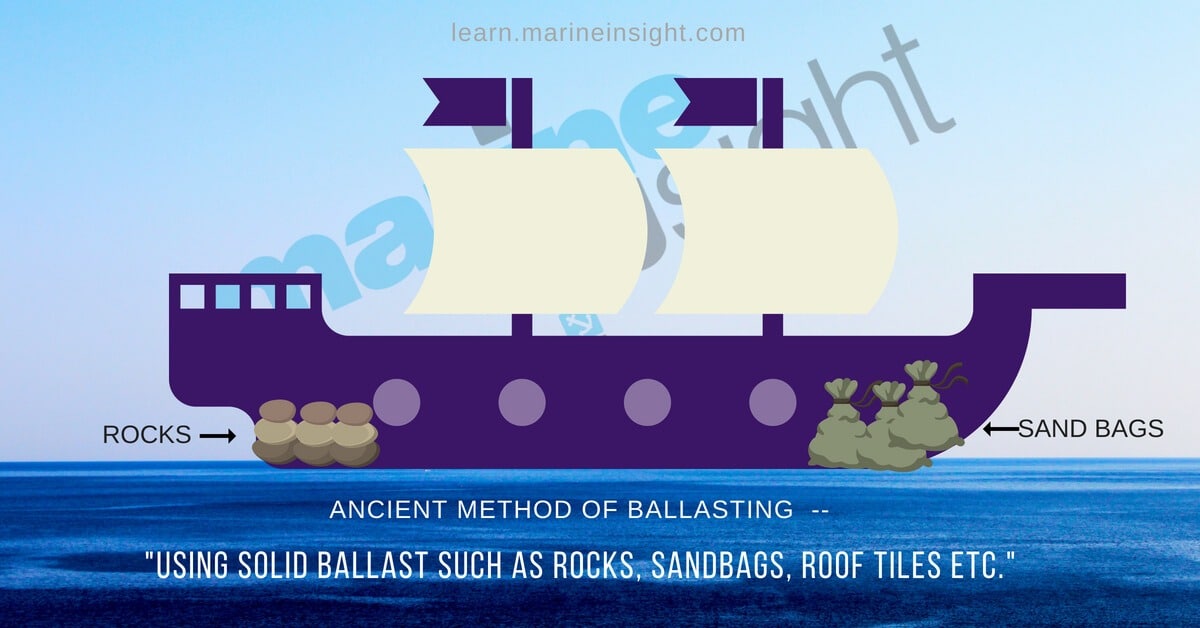
Why is Ballast Water Taken in the Tanks?
Let’s assume that the vessel does not have a ballast system. In such cases, the following conditions may arise:
- The propeller may not fully immerse in water, affecting the engine efficiency of the ship
- The ship may list or trim as the cargo capacity of the ship is not fully reached
- The shear and torsion loads on the vessel may increase the stresses on the ship structure, leading to bending moments and slamming
- The vessel may face issues of dynamic transversal and longitudinal instability
Related Read: Different Technologies To Measure Hull Stresses In Ships
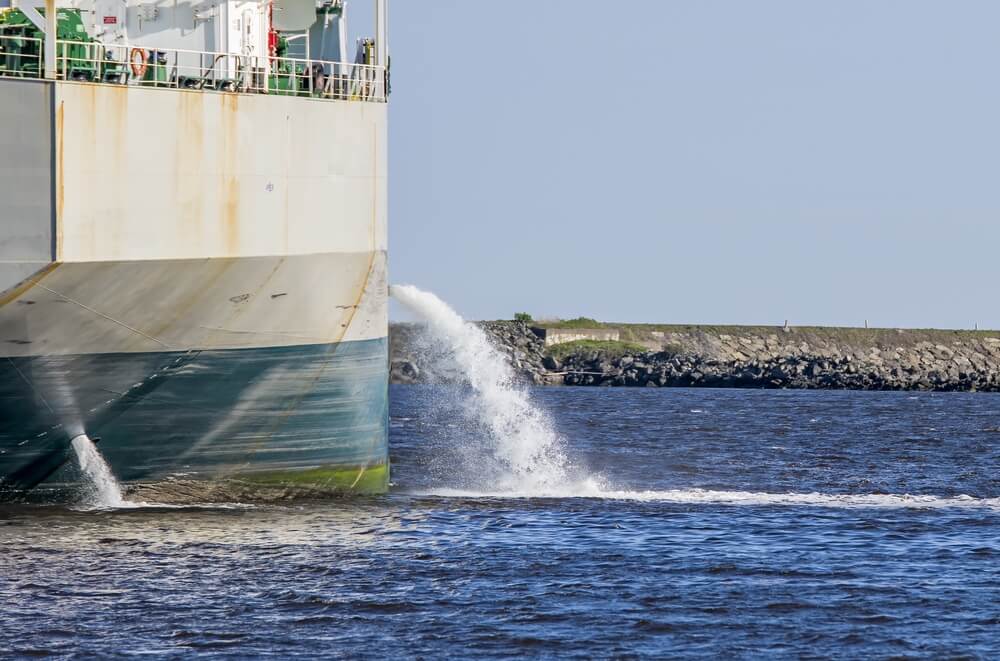
To compensate for the above conditions, ballast water is taken on board vessels to ensure safe operating conditions during a specific voyage. It can be said that ballasting of ship fulfils the following:
- Ballasting of ship helps in reducing ship’s stresses on the hull of the vessel. It also provides for transverse stability of the ship
- As the propeller is submerged, it aids the propulsion plant in maintaining its efficiency
- Ballast helps in immersing the rudder, supporting the manoeuvrability of the vessel and also reducing the exposed hull surface
- The ship continually uses fuel and water from its tanks leading to weight loss. The ballast operation helps in compensating for the weight loss
Related Read: Everything You Wanted to Know About Ballast Water Exchange and Management Plan
Types Of Ballast Conditions
The Chief Officer and Master of the ship are responsible for adding or removing ballast water in the ship’s ballast tanks, depending on the ship stability condition. There are mainly three types of ballast conditions:
– Light Ballast: When the ship is heavily loaded, and it does not require an additional ballast, the water ballast tanks are kept empty. This condition is known as a light ballast.
– Heavy Ballast: During the seagoing state, if the ship is not fully loaded, ship ballast tanks are filled to its capacity. This condition is known as a heavy ballast.
– Port Ballast: Many ports around the world have a restriction for usage of ballast water. Dedicated port ballast tanks are provided to correct the trim and list of the ship during loading or discharging operation, and this is called port ballast.
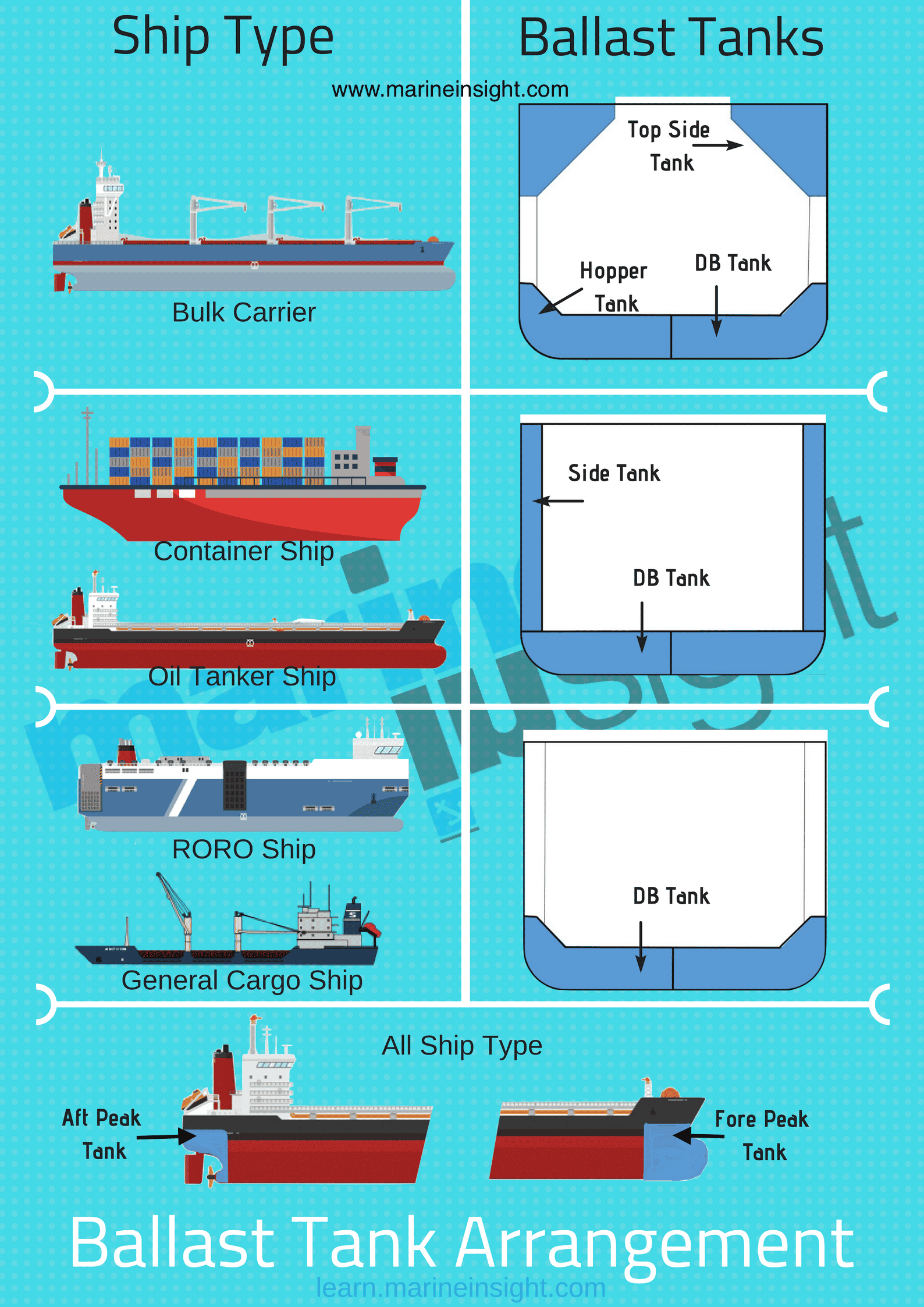
Types of Ship Ballast Tanks as Per The Location
The water ballast tanks are provided at different locations depending upon the type of ship. Following are some of the most common locations for the construction of ballast tanks on ships:
Topside Tanks
As the name suggests, these are tanks are located on the topside corner of the ship. The topside tanks are triangular in shape fitted with wings on both sides of the cargo holds. They are more common in bulk carrier ships and are constructed using transverse frames arranged in the following ways:
1. A deck transverse under the main deck which supports the deck plating
2. Bottom transverse which forms the part of the supporting frame for the bottom area of the topside tank
3. Side transverse forms the part of the structure for supporting the side shell plating of the tank, which is kept in line with the side shell frames within the cargo holds (in single skin bulk carriers)
Related Read: Understanding Design Of Bulk Carriers
These tanks are directly connected to the ship’s main ballast pipelines and during the cargo loading/ discharging operation, the volume of the ship ballast water in the topside tank is kept in equilibrium with the cargo weight.
The design of the topside tanks helps in avoiding a shift of the cargo in inaccessible spaces for the grab as these tank designs help in carrying the cargo such as grain etc. without the need of a trim.
Lower Hopper Tanks
Similar in construction to the topside ballast tanks, these water ballast tanks are located on the bottom wing sides of each cargo hold of the ships, and they are kept in continuation to the double bottom tanks which run through the centre of the vessel. The hopper tanks provide the following advantages:
- They act as additional ballast space for the ship
- Their design offers slopes in the cargo hold corner which ease the collection of the cargo in the mid position of the hold for better discharging/stripping
- The adjacent fuel tank plating of the hopper tank forms a slant boundary to carry the static and dynamic load during cargo loading and ballasting.
Related Read: A Detailed Explanation on How to Operate a Ship’s Ballast System
Double Bottom (DB) Tanks
The double bottom of the ship is a safety feature to avoid ingress of water in case of grounding or collision. These void spaces are used to store ship ballast water to stabilize the ship.
The double bottom tanks are located between the forward part (till collision bulkhead ) to the aft peak bulkhead, dividing the engine room.
In some ships, such as container and bulk ships, the double bottom space is divided transversely into three sections (instead of two). This is done to provide a cofferdam in the centre known as the duct keel’ which are used to carry ballast and bunker tank valves, and pipings for ships ballast tank and bunkering system.
The construction of the DB tanks is directly related to the length of the ship as the vessel with more than 120 m will have additional longitudinal framing in comparison with transverse framing for vessels of less than 120 m lengths.
Unlike upper topside tanks, these water ballast tanks are adjacent to the fuel oil tanks in the double bottom. Hence, they are usually not connected to the ballast system to avoid any chance of contamination.
Related Read: Designing A Ship’s Bottom Structure – A General Overview
Fore and Aft Peak Ballast Tanks
The fore and aft peak ballast tanks are provided to perform precise trimming operations of the ship. To achieve the required trim these tanks are hardly filled partially to avoid the free surface effect of the liquid
The construction of the fore and aft peak tanks is different from the other ship’s ballast tank as their shape is pretty irregular due to the location and their shape highly depends on the bow and the stern design of the vessel.
The design of these ship ballast tanks is narrow at the bottom end, and as the tank moves upward, the width of the tank increases significantly. The tank breadth corresponds to the breadth of ships’ hulls.
Related Read: Loads Acting On Fore And Aft Regions Of Ships
The valve used to control the flow of water in the ballast tank can either be a manually controlled butterfly valve or a hydraulically operated remote valve . For fore and Aft peak tanks, only remote control (hydraulic) valves are used due to their location.
Types of Ballast Tanks As Per Usage On Oil Tankers
The oil tanker ships have a different set of regulations for the ballast tanks. The two main types as per the usage are:
Clean Ballast Tanks (CBT)
- Segregated Ballast Tanks (SBT)
As per MARPOL Annex 1, Regulation 18 – Every crude oil tanker of 20,000 tonnes deadweight and above and every product carrier of 30,000 tonnes deadweight and above delivered after 1 June 1982, as defined in regulation 1.28.4, shall be provided with segregated ballast tanks.
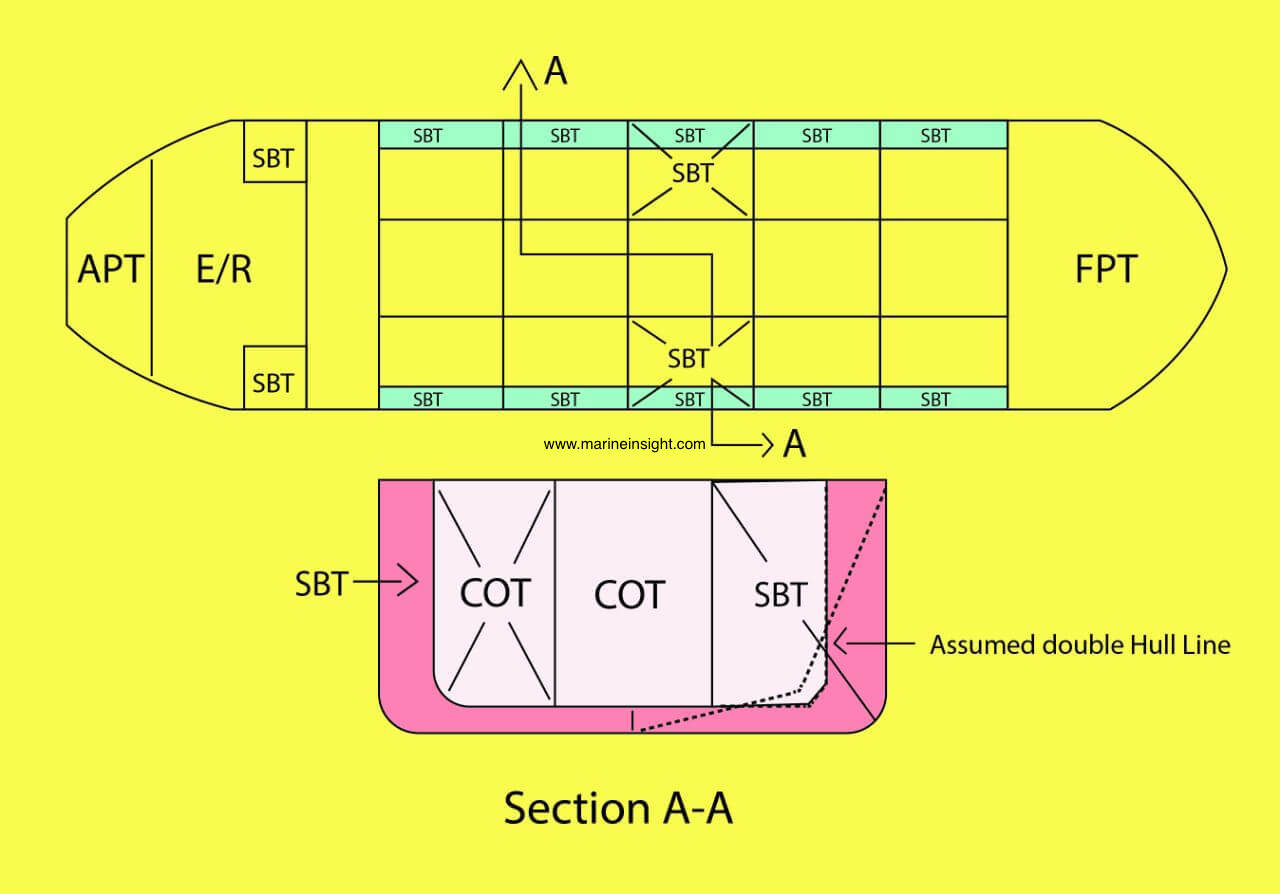
Segregated Ballast Tanks
The segregated ballast tanks (SBT) are dedicated tanks constructed for the sole purpose of carrying ballast water on oil tanker ships. They are completely separated from the cargo, and fuel tanks and only ballast pumps are used in the SBT.
The Segregated ballast tanks avoid any chances of mixing oil and water which usually happens when cargo holds are used to carry ballast water.
The oil tankers may travel without carrying cargo in its holds which may lead to stability issues. Especially in bad weather. Hence, the cargo holds which carried oil in the last voyage are cleaned and then filled with clean ballast water.
During the discharge of ballast water, an oil content monitor control is used and the only effluent which is <15ppm is discharged overboard, and rest is transferred to the slop tanks.
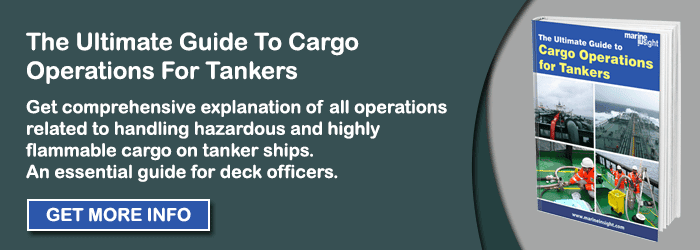
Ballast Tank Monitoring
Level Monitoring: The water ballast tank on the ship is installed with the level sensors to control the valves and ballast pumps for safe ballasting/ de-ballasting operation.
Multiple ballast pumps are provided in the engine room which takes the suction from the main seawater line (from sea chest) and during the deballasting operation, they discharge the water from ballast overboard line and valve. The CCR is provided with the ballast tank level monitoring system, and the pump cutoff is controlled once the water level reaches the sensor level to activate the trip.
Related Read: Common Problems Found in Pumps on Board Ships
Atmosphere monitoring:
In oil tanker ships , the ballast tank is provided with gas measuring sensors at various levels- usually, upper and bottom levels.
During the loaded condition of the ship, the ballast tank will be kept empty. In such situation, the three-way valve in the sampling line will be set towards the lower sampling point.
When the ship is the ballast/partial ballast condition, it will be turned to activate the top sampling point. This is done to avoid the entrance of water into the analysing unit through the sampling points.
Related Read: Hazards On Oil Tanker Ship Every Seafarer Must Know
Volume Monitoring:
The volume monitoring of the ballast tank is done to achieve the ballast/ deballast rate of the pumping system. This is done by the loadicator software installed on the ship, and the ship’s officer will manipulate the results displayed by the loadicator to operate the fill/ discharge valve of the ballast tank.
The change in the volume of the ballast tank is used to calculate the ballast pump rate, which in turn, determines the time needed to finish the ballasting or deballasting operation . This helps the chief officer to complete the stability operation in time to maintain the ship’s Estimated Time of Departure (ETD).
Ballast Tank Protection
The ballast tank is filled with seawater, which is highly corrosive in nature. When the tank is empty, the dampen atmosphere will also increase the corrosion attack on the ballast tank surface.
Corrosion is a major problem on ships. Following methods are used for protection against corrosion:
Tank Coating:
Coating in the tank surface is the most common protection system used on the ship. The advantage of the coating is that it protects the entire tank at a time and if the right quality of coating is applied, the ballast tank can work without any problem for a long period. It is the layer of the coating which protects the seawater to come in contact with the steel of the tank.
The coating dry film thickness can be as thin as 300 microns. The most common type of coating used is; heavy-duty dual-component epoxy coating.
Related Read: Fundamental Conditions to Check While Inspecting Tanks Onboard Ships
Use of sacrificial anodes is very popular inside the tanks to control the corrosion. Zinc, aluminium and their alloys with other metals such as tin are a popular choice of anodes used onboard.
Magnesium anodes are not to be used in the ship ballast water tanks as they tend to generate hydrogen, while in operation, which can have deleterious effects on some ballast tank coatings.
Aluminium anodes are not used in oil tankers as they are prone to spark hazard if dropped from significant heights.
Controlled Atmosphere:
If the atmosphere of the ballast tank can be controlled to reduce the oxygen content, the corrosion rate decreases drastically. This system is known as oxygen stripping which is done by introducing inert gas to maintain the oxygen level in the tank below 4%.
This system is used with the tank with a protective coating and even with anodes fitted tanks (to extend the life of sacrificial anodes). It reduces the corrosion to as much as 84%.
The advantages of this system is:
- Decrease the coating maintenance and steel renewal
- Increases the life of anodes
- Reduces life cycle costs of ballast tank maintenance
Ballast Tank Inspection:
The ships’ officer must know the following conditions which need to be regularly inspected inside the ballast tank of the ship:
Corrosion for Ballast Tanks
The extent of corrosion inside tank surface should be noted, and localised corrosion should be marked appropriately. If the corrosion wastes of the tank surface exceed 75% of the allowable margin, repair such as renewal of hull structural to be carried out.
Coating Condition:
Coating plays an important role in ship ballast water tank surface protection hence proper inspection of coating to be performed. Visible failure of the coating to be noted along with rusting of tank surface especially on the weld lines and edges of the tanks.
The tank structure to be inspected for cracks or buckling. The strengthening arrangement to be checked for bent or cracks and same to be repaired at the next possible opportunity.
The history of the ships (previous inspection records) plays a critical role in the current inspection method followed and even records of sister vessel can be used to decide for repair, if needed, followed by a survey and pressure testing of the ballast tank post repairs.
Disclaimer : The information contained in this website is for general information purposes only. While we endeavour to keep the information up to date and correct, we make no representations or warranties of any kind, express or implied, about the completeness, accuracy, reliability, suitability or availability with respect to the website or the information, products, services, or related graphics contained on the website for any purpose. Any reliance you place on such information is therefore strictly at your own risk.
In no event will we be liable for any loss or damage including without limitation, indirect or consequential loss or damage, or any loss or damage whatsoever arising from loss of data or profits arising out of, or in connection with, the use of this website.

Do you have info to share with us ? Suggest a correction
Daily Maritime News, Straight To Your Inbox
Sign Up To Get Daily Newsletters
Join over 60k+ people who read our daily newsletters
By subscribing, you agree to our Privacy Policy and may receive occasional deal communications; you can unsubscribe anytime.

About Author
An ardent sailor and a techie, Anish Wankhede has voyaged on a number of ships as a marine engineer officer. He loves multitasking, networking, and troubleshooting. He is the one behind the unique creativity and aesthetics at Marine Insight.
Read More Articles By This Author >

BE THE FIRST TO COMMENT
Thank You for this short information about ballast tanks. This information verry good for cargo officers.
Please always post relevant information regarding Marine Ship design, Latest IMO Rules Regulation.
Assuming that most crude oil is shipped to northern hemisphere, rich in fresh water resources
If, say 3000 crude oil tankers visit Saudi Arabia yearly, & they loaded fresh water ballast for trip back to Saudi, even if it was only half the crude barrels it might amount to 4,5 billion barrels of water – a valuable resource
Is this being done currently?
Leave a Reply
Your email address will not be published. Required fields are marked *
Subscribe to Marine Insight Daily Newsletter
" * " indicates required fields
Marine Engineering
Marine Engine Air Compressor Marine Boiler Oily Water Separator Marine Electrical Ship Generator Ship Stabilizer
Nautical Science
Mooring Bridge Watchkeeping Ship Manoeuvring Nautical Charts Anchoring Nautical Equipment Shipboard Guidelines
Explore
Free Maritime eBooks Premium Maritime eBooks Marine Safety Financial Planning Marine Careers Maritime Law Ship Dry Dock
Shipping News Maritime Reports Videos Maritime Piracy Offshore Safety Of Life At Sea (SOLAS) MARPOL
WAIT! Did You Download 13 FREE Maritime eBooks?
Sign-up and download instantly!
We respect your privacy and take protecting it very seriously. No spam!
What Is Ballast Water? Why Is It a Problem?
Many of the world's invasive marine species are directly connected to ballast water carried by ships
- Chapman University
:max_bytes(150000):strip_icc():format(webp)/ScreenShot2021-04-07at1.57.45PM-bcef177316c94cdf998457c694cce6d5.png)
- University of Tennessee
- Public Transportation
Ballast Water Definition
Environmental impact.
- Management Systems
- Exchange Methods
Ballast water is freshwater or ocean water stored in a ship's hull to provide stability and improve maneuverability during a voyage. When the ship reaches its destination, the ballast is emptied into the water at the new port, sometimes filled with a flurry of uninvited guests in the form of bacteria, microbes, small invertebrates, eggs, or larvae of various species that have hitched a ride from the original destination and may become invasive species .
When a ship receives or delivers cargo to a number of different ports, it will take or release ballast water at each one, creating a mixture of organisms from several different ecosystems. Some ships aren’t designed to carry ballast water, while others are able to carry permanent ballast water in sealed tanks to bypass the process altogether. In general, however, almost all sea-going vessels will take on some kind of ballast water.
Ballast is water brought on board to manage the ship's weight. It’s a practice that’s as old as steel-hulled ships themselves, and it helps reduce stress on the vessel, compensate for weight shifts as cargo loads change, and improve performance while navigating rough seas. Ballast water may also be used to increase the load so that a ship can sink low enough to pass under bridges and other structures.
A ship may carry anywhere from 30% to 50% of its total cargo in ballast, ranging from a hundred gallons to more than 2.5 million gallons depending on the ship’s size. According to the World Health Organization's Guide to Ship Sanitation , about 10 billion metric tonnes (approximately 11 billion U.S. tons) of ballast water are transported by ship around the world every year.
Why is this a problem? If an organism transferred through ballast water survives long enough to establish a reproductive population in its new environment, it can become an invasive species . This can cause irreparable damage to biodiversity as the new species outcompetes native ones or multiplies into uncontrollable numbers. Invasive species don’t just affect the animals who live there, but they can also devastate the economies and health of the local communities who rely on that balance for food and water.
Many of these foreign aquatic species have been responsible for some of the most profound damage to water bodies in recorded history. Invasions of zebra mussels in freshwater lakes, for example, can cause native fish species to grow slower in their first year of life. The round goby, another notorious invasive species, changes the food chain in its new habitat so quickly that it can increase the bioaccumulation of toxic substances in larger predatory fishes, putting the humans who eat them at risk.
And, according to the International Maritime Organization (IMO), the rate of bio-invasions is increasing at an "alarming" rate:
"The problem of invasive species in ships’ ballast water is largely due to the expanded trade and traffic volume over the last few decades and, since the volumes of seaborne trade continue to increase, the problem may not have reached its peak yet. The effects in many areas of the world have been devastating.”
It's not just sea environments under threat from ballast water—ships that travel through the open ocean to lakes are just as dangerous. According to the United States Environmental Protection Agency (EPA), at least 30% of the 25 invasive species introduced to the Great Lakes since the 1800s entered the ecosystems through ship ballast water.
The IMO set out guidelines for ballast water in 1991 under the Marine Environment Protection Committee, and after years of international negotiations, adopted the International Convention for the Control and Management of Ships' Ballast Water and Sediments (also known as the BWM Convention) in 2004. That same year, the U.S. Coast Guard established rules for controlling the discharge of organisms from ship ballast water in the United States.
The Coast Guard rules prohibiting ships from discharging untreated ballast water in U.S. waters went into effect in 2012, while the 2004 BWM Convention program for the development of ballast water guidelines and procedures came into effect in 2017. In 2019, the EPA proposed a new rule under the Vessel Incidental Discharge Act , though it has been criticized by conservation groups since it contains an exemption for large ships that operate in the Great Lakes.
Some Species Transported in Ballast Water
- Cladoceran water flea: introduced to the Baltic Sea (1992)
- Chinese mitten crab: introduced to Western Europe, Baltic Sea, and the North American West Coast (1912)
- Various strains of cholera: introduced to South America and the Gulf of Mexico (1992)
- Various species of toxic algae: introduced to numerous regions (1990s and 2000s)
- Round goby: introduced to the Baltic Sea and North America (1990)
- North American comb jelly: introduced to the Black, Azov, and Caspian Seas (1982)
- Northern Pacific Seastar: introduced to Southern Australia (1986)
- Zebra mussel : introduced to western and northern Europe and the eastern half of North America (1800-2008)
- Asian kelp: introduced to Southern Australia, New Zealand, West Coast of the United States, Europe, and Argentina (1971-2016)
- European green crab : introduced to Southern Australia, South Africa, the United States, and Japan (1817-2003)
Ballast Water Management Systems
Following the 2004 BWM Convention , different ballast water management strategies have been implemented around the world, using both physical (mechanical) and chemical methods. In many situations, different combinations of treatment systems are necessary to address varied species of organisms living inside a single ballast tank.
Some chemicals, while they have the power to inactivate 100% of organisms in ballast water, create high concentrations of toxic byproducts that can be harmful to the very native organisms they are trying to protect. Reducing these biocides can add another step to the treatment process, making the use of chemicals alone a costly and inefficient method. Even chemical treatments known to act faster than mechanical ones will likely cause more harm to the environment from toxic byproducts in the long run.
Environmentally speaking, using a primary mechanical treatment, such as removing particles with disk and screen filters during loading or using UV radiation to kill or sterilize the organisms outright, is considered the best option—at least for now.
Mechanical treatment methods can include filtration, magnetic separation, gravity separation, ultrasound technology, and heat, all of which have been found to inactivate organisms (especially zooplankton and bacteria). Studies have shown that filtration followed by the chemical compound hydroxyl radical is the most energy-efficient and cost-effective treatment method, plus it can inactivate 100% of organisms in ballast water and produces a low amount of toxic byproducts.
Ballast Water Exchange Methods
Beginning in 1993 , international ships were required to exchange their freshwater ballast water with saltwater while still at sea, which was effective at killing any organisms that may have entered into the hull at its original port. By 2004, even smaller cargo ships containing no ballast water were required to take on a limited amount of seawater and eject it before entering port to prevent the unintentional transportation of invasive species.
To perform a ballast water exchange, the ship must be at least 200 nautical miles from the nearest landmass and operating in water at least 200 meters deep (656 feet). In some cases with boats that make shorter journeys or work in enclosed waters, the ship must exchange ballast water at least 50 nautical miles from the nearest land, but still in water that is 200 meters deep.
Ballast water exchange methods are most effective if the initial water originated from a freshwater or brackish source, since the abrupt salinity change is lethal to most freshwater species. Given the fact that efficient exchange is dependent on specific environments, such as changes in salinity or temperature, ships traveling from freshwater to freshwater, or from ocean to ocean, won’t benefit as much from ballast water exchange. There are, however, studies that show a combination or exchange plus treatment as more effective than treatment alone when destination ports are freshwater. Exchange followed by treatment also serves as an important backup strategy should onboard treatment systems fail.
" Chapter 5: Ballast Water ." Guide to Ship Sanitation, 3rd edition. World Health Organization, 2011.
" Invasive Species ." U.S. Fish and Wildlife Service .
Hansen, Gretchen, et al. " Walleye Growth Declines Following Zebra Mussel and Bythotrephes Invasion ." Biological Invasions , vol. 22, 2020, pp. 1481-1495, doi:10.1007/s10530-020-02198-5
Ojaveer, Henn, et al. " Twenty Five Years of Invasion: Management of the Round Goby Neogobius Melanostomus in the Baltic Sea ." Management of Biological Invasions , vol. 6, no. 4, 2015, pp. 329-339., doi:10.3391/mbi.2015.6.4.02
" Ballast Water Management ." International Maritime Organization .
" Invasive Species in the Great Lakes ." Environmental Protection Agency .
Lakshmi, E., et al. " An Overview on the Treatment of Ballast Water in Ships ." Ocean and Coastal Management , vol. 199, 2021, pp. 105296., doi:10.1016/j.ocecoaman.2020.105296
" International Convention for the Control and Management of Ships' Ballast Water and Sediment (BWM) ." International Maritime Organization .
Bradie, Johanna, et al. " Ballast Water Exchange Plus Treatment Lowers Species Invasion Rate in Freshwater Ecosystems ." Environmental Science & Technology , vol. 55, no. 1, 2015, pp. 82-89., doi:10.1021/acs.est.0c05238
- Why We Don't Need Electric Cars, but Need to Get Rid of Cars
- Why We Need Fewer, Smaller, Lighter, Slower Cars: Plastic Particulates From Tire Wear Are Being Found in the Arctic
- How Do We Deal With People Riding Bikes on the Sidewalk?
- More People Are Riding on E-Scooters, So More People Are Getting Injured
- Why Your Car Can't Read Your CD Tracks
- New York State Lawmakers Want to Ban Walking With Portable Electronic Devices
- Alpen Introduces Personal Bike Storage
- Eco-Friendly Car Wash
- Life With a Used Nissan Leaf: 18 Months On
- Why Can't We Solve the Modern Traffic Jam?
- How to Remove Rust, and How to Prevent It in the First Place
- Let’s Stop Even Talking About E-Bikes Being “cheating”
- Why Do Americans (And Elon Musk) Hate Public Transit So Much, and Love Chasing "Cyberspace Techno-Dreams"?
- National Fabric of Canada Torn Asunder Over Pickup Trucks
- How to Reduce Your Carbon Footprint From Flying
- The Robots Are Coming for Your Bike Lanes

A tanker size range defined by Clarksons as between 80,000 and 120,000 dwt.
Ballast voyage
A voyage with no cargo on board to get a ship in position for the next loading port or docking. On voyage the ship is said to be in ballast.
Bareboat charter
The hire or lease of a vessel from one company to another (the charterer), which in turn provides crew, bunkers, stores and pays all operating costs.
Battery metals
See more in our battery metals guide here.
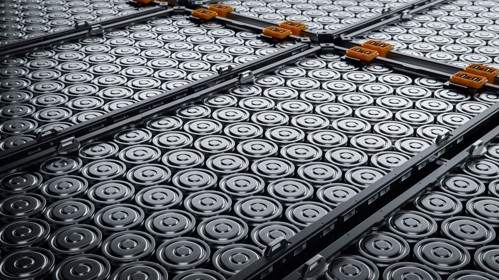
Baltic and International Maritime Council. See more in our BIMCO guide here.

The ship's fuel.
Transport of goods between two ports or places located in the same country, often restricted to domestic carriers. See more in our cabotage guide here.

Bulk ship size range defined by Clarksons as 100,000 dwt or larger.
Carbon capture and storage
See more in our carbon capture and storage guide here.

Compensated gross tonnage. This unit of measurement was developed for measuring the level of shipbuilding output and is calculated by applying a conversion factor, which reflects the amount of work required to build a ship, to a vessel's gross registered tonnage.
Cargo Ships
See more in our ultimate cargo ships guide here.
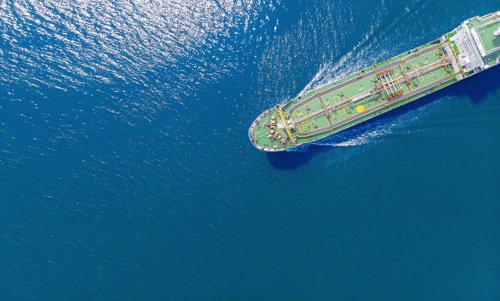
See more in our charter types guide here.

Cargo owner or another person/company who hires a ship.
Charter-party
Transport contract between shipowner and shipper of goods.
Cost, insurance and freight. Delivery of goods is the seller's responsibility to the port of discharge. The freight is paid for by the supplier of goods. See more in our CIF guide here.

ClarkSea Index
A weighted average index of earnings for the main vessel types where the weighting is based on the number of vessels in each fleet sector.
Refined oil products such as naphtha.
Contract of Affreightment. An agreement to transport a defined amount of cargo at an agreed freight rate, with the shipowner choosing the ship. See more in our COA guide here.

Combination carrier
Ship capable of carrying oil or dry bulk cargoes, thereby increasing the productivity of the vessel. Typically termed OBO or Ore/Oiler.
Commodities derivatives
See more in our commodities derivatives guide here.

Naturally occurring substance in oil and gasfields which can be shipped in tankers.
Crew transfer vessels
See more in our crew transfer vessel guide here.
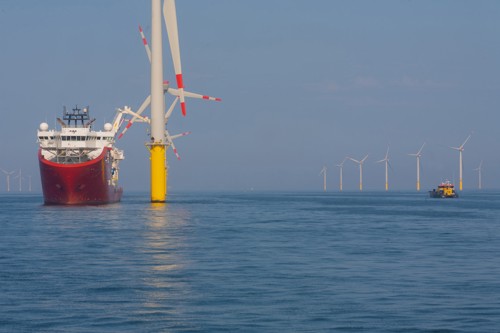
Unrefined oil.
See more in our crude oil guide here.

See more in our customs clearance guide here.

Daily operating costs
The costs of a vessel's technical operation, crewing, insurance and maintenance, but excluding costs of financing.
Money paid to shipowner by charterer, shipper or receiver for failing to complete loading/discharging within time allowed according to charter-party. See more in our demurrage guide here.

Less refined oil products such as fuel oil.
Dry (market)
Generic term for the bulk market.
Dry bulk cargo
Unpackaged cargoes such as coal, ore and grain. See more in our dry bulk guide here.

Dry cargo carrier
A ship carrying general cargoes or sometimes bulk cargo.
Dry docking
To put a vessel into a dry dock for inspection, repair and maintenance. Normally done on a regular basis. See more in our dry docking guide here.

Deadweight ton. A measure expressed in metric tons (1,000 kg) or long tons (1,016 kg) of a ship's carrying capacity, including bunker oil, fresh water, crew and provisions. This is the most important commercial measure of the capacity.
Energy transition
See more in our energy transition guide here.

Vessels of under 2,500 teu which distribute containers regionally between hub ports.
A Forward Freight Agreement is a cash contract for differences requiring no physical delivery based on freight rates on standardised trade routes.
Free On Board. Cost of the delivery of goods is the seller's responsibility only up to the port of loading. The freight is paid for by the buyer of the goods. See more in our FOB guide here.
FOB (estimate)
Forward Order Book represents estimated commissions collectable over the duration of the contract as principal payments fall due. The forward order book is not discounted.
Forward Ship Value Agreement. An FFA based product designed specifically for the sale and purchase market.
Free trade agreement
See more in our free trade agreement guide here.

Freight Forwarding
Freight forwarding involves the movement of goods via air, sea, rail and/or road. See more in our freight forwarding guide here.
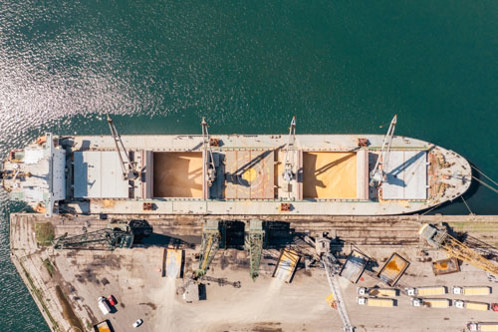
Freight rate
The agreed charge for the carriage of cargo expressed per ton(ne) of cargo (also Worldscale in the tanker market) or as a lump sum. See more in our freight rate guide here.

Green shipping
See more in our green shipping guide here.

Handysize/Handymax
Bulk ship size ranges of ships defined by Clarksons as 10-40,000 dwt and 40-60,000 dwt.
International Maritime Organisation: a United Nations agency devoted to shipping. See more in our IMO guide here.

See more in our incoterms guide here.
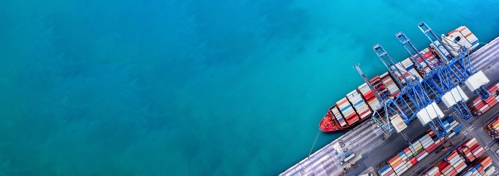
International Safety Management code for the safe operation of ships and for pollution prevention as adopted by the IMO. See more in our ISM code guide here.

Large Gas Carrier. Vessel defined by Clarksons as 40,000-60,000 cbm.
Liquified Natural Gas. See more in our LNG guide here.
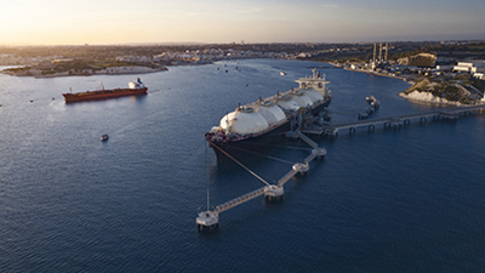
Liquified Petroleum Gas. See more in our LPG guide here.
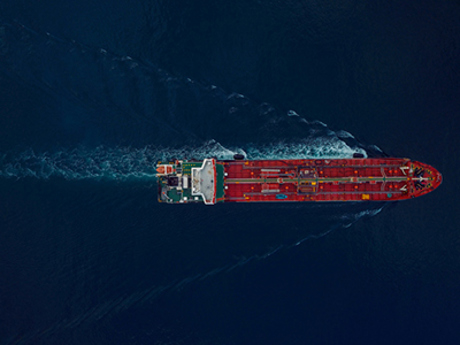
Maritime Law
See more in our maritime law guide here.
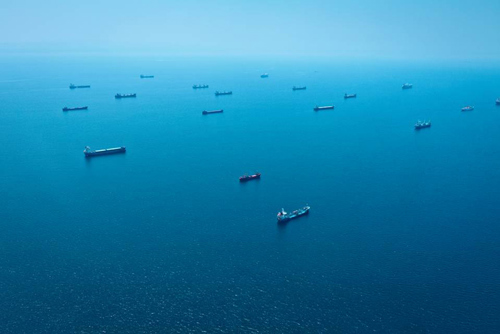
Mini Bulk Carrier Ship
Ensuring the safe and efficient shipping of goods may be critical to your operations. See more in our mini bulk guide here.
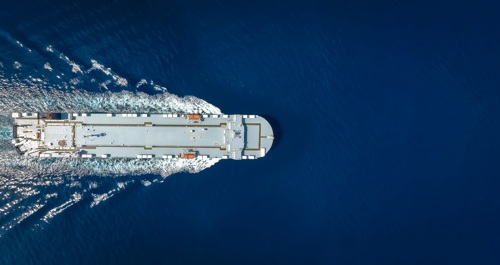
Memorandum of agreement.
Oil, Bulk, Ore carrier (see Combination carrier).
Offshore Renewable Energy
Offshore renewable energy, including wind, wave, tidal & thermal. See more in our offshore energy guide here .

Offshore Wind Turbine Installation
See more in our offshore wind turbines installation guide here.
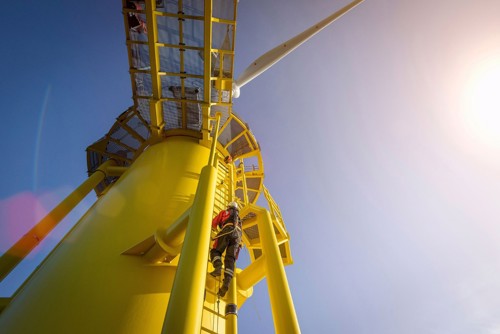
Tanker carrying crude oil or refined oil products.
Bulk ship size range defined by Clarksons as 60-100,000 dwt. Strictly speaking the largest ship capable of navigating in the Panama Canal.
Parcel tanker
Tanker equipped to carry several types of cargo simultaneously.
Post fixture
Operational administration of a vessel once employed.
Product tanker
Tanker that carries refined oil products.
A vessel capable of handling refrigerated cargoes such as meat, fish and fruit.
Regasification
See more in our regasification guide here.

An abbreviation for roll-on roll-off, describing vessels where vehicles drive onto and off the vessels.
A person/company who on behalf of shipowner/shipper negotiates a deal for the transportation of cargo at an agreed price. Shipbrokers also act on behalf of shipping companies in negotiating the purchasing and selling of ships, both second-hand tonnage and newbuilding contracts.
The term ‘shipping’ refers to the transport of cargo as a business. See more in our shipping guide here.
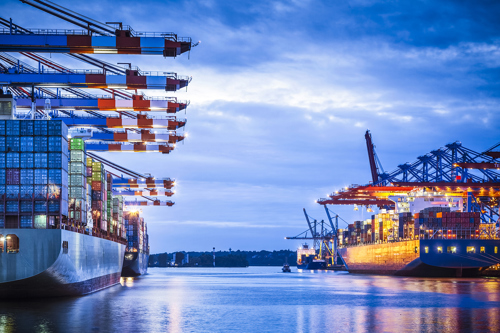
Ship maintenance and repair
See more in our ship maintenance and repair guide here.
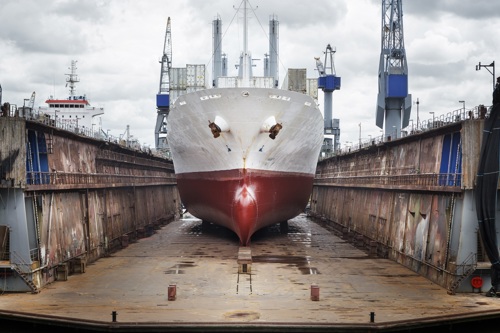
Shuttle tanker
Tanker carrying oil from offshore fields to terminals.
Spot business
Broker commission negotiated and invoiced within the same business year.
Spot market
Short-term contracts for voyage, trip or short-term time charters, normally no longer than three months in duration.
Spot shipping
See more in our spot shipping guide here.
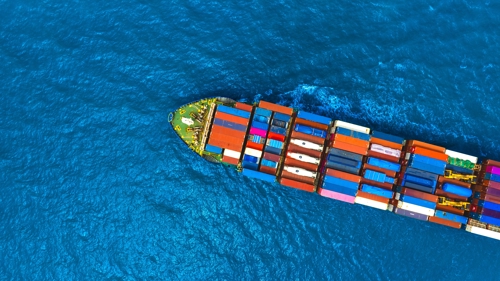
A tanker size range defined by Clarksons as 120,000-200,000 dwt.
Twenty foot Equivalent Units. The unit of measurement of a standard twenty-foot-long container.
Time charter (t/c)
An arrangement whereby a shipowner places a crewed ship at a charterer's disposal for a certain period. Freight is customarily paid periodically in advance. The charterer also pays for bunker, port and canal charges.
Time Charter Equivalent (TCE)
Gross freight income less voyage costs (bunker, port and canal charges), usually expressed in US$ per day.
Imperial/Metric ton of 2,240 lbs/1,000 kilos (2,204 lbs).
Ultra Large Crude Carrier. Tanker of more than 320,000 dwt.
Vacuum gas oil
Similar to fuel oil.
Vessel sizes
See more in our bulk vessel size guide here.
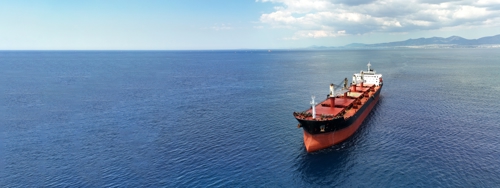
Very Large Crude Carrier. Tanker between 200,000 and 320,000 dwt.
Very Large Gas Carrier. Vessel defined by Clarksons as more than 60,000 cbm.
Voyage charter
The transportation of cargo from port(s) of loading to port(s) of discharge. Payment is normally per ton(ne) of cargo, and the shipowner pays for bunker, port and canal charges.
Voyage costs
Costs directly related to a specific voyage (e.g. bunker, port and canal charges).
Wet (market)
Generic term for the tanker market.
Worldscale (WS)
An international index of freight for tankers. Worldscale is a schedule of freight rates for a standard ship in US dollars per tonne of oil for an array of oil routes. The rates listed in the table are designated as Worldscale Flat or WS100 and are revised annually.

What is ballast water?
Why commercial ships carry ballast water on board, and how it affects the marine environment..

Large cargo ships use ballast water to balance their weight and keep them stable during a voyage. Although it is essential for the safety of the ship, ballast water can be harmful to the marine environment as its discharge can release potentially invasive species into a new marine environment.
Proper management and treatment of ballast water significantly reduces this risk.
Ballast is extra weight added to a ship when it unloads its cargo – without it, the ship would pop out of the water like a cork and could become unstable.
Prior to the 1880s, ships used solid ballast materials such as rocks and sand, which people had to shovel into and out of cargo holds. If not properly secured, solid ballast could shift in heavy seas, risking capsizing.
With the introduction of steel-hulled ships and automatic pumping technologies in the 20th century, water became a safer ballast material for ships.
When ships need ballast, water is easily pumped into ballast tanks from the sea or the inland waters where the ship is located, which adds weight to the bottom and sides of the vessel.
Ballast water is pumped out into the ocean when it is no longer needed (when the weight of the ship needs to be lightened) – for example, when the ship is taking on cargo.
Ballast water can be disposed of on land while ships are at berth; however, this practice is not common as it is costly and requires specialized equipment and complex processes.
Ballast tanks are an integral part of a ship’s design with their number and size varying according to the vessel’s type and construction.
Ships can have a range of ballast capabilities and capacities, but generally ballast equates to 25% to 30% of the weight the ship can carry – including cargo, fuel, crew, passengers, food, and water – or its dead weight tonnage.
Ballast water is crucial for the safe operation of ships. It is used to adjust the distribution and overall weight of the vessel to keep the ship floating upright and in a safe, stable condition.
Ballast is used to compensate for different cargo loads that a ship may carry at different times, including changes in weight during loading and unloading. It also provides stability and manoeuvrability during a ship’s voyage.
Ballasting – the process by which a commercial vessel pumps water in or out its ballast tanks while in transit or at a port – is essential for safety, especially if the ship is carrying a heavy load in one hold and a lighter load in another, or empty and facing rough seas.
Ballasting is not to be confused with “bunkering” – the process by which a ship’s fuel tanks (called bunker tanks) are filled with the marine fuel (called bunker fuel ) needed for the voyage.
Loading and unloading untreated ballast water can pose a major threat to the environment, public health and the economy as ships become a carrier for the transfer and spread of threatening invasive aquatic species , from one part of the world’s oceans to another.
When ballast water is pumped into a ship, sediment and microscopic organisms are also transferred into the ballast tanks. These organisms include bacteria, microbes, small invertebrates, eggs, cysts, and larvae of various species.
Many of these organisms are able to survive for extended periods in inhospitable environments, including a ship’s ballast tanks. When the ballast water is discharged, the organisms are released into the local marine environment.
Without their natural predators and given the right conditions these foreign species will not only survive but can also flourish, becoming invasive and threatening and even eliminating resident populations.

The zebra mussels’ invasion of the Great Lakes is one example of the devastation a species can cause when introduced to a new marine environment.
Since its arrival in the late 1980s due to ship ballast water discharge, this freshwater mussel, native to the Black and Caspian Seas in Europe, has caused significant environmental damages, including disrupting the local food chain.
Because they reproduce quickly and in large numbers – it is estimated that females can lay as many as one million eggs per year – zebra mussels rapidly overwhelm local species such as native mussels, feeding on the same food sources and hampering native species’ growth and development.
Zebra mussels can also attach to and suffocate native mussels, causing them to die. Over the years, zebra mussels have continued to spread in Canadian waters and have been found in Quebec (St. Lawrence River) and Manitoba (Lake Winnipeg).
This invader has also cost billions of dollars for cleaning and repairs to underwater infrastructure, for example clearing clogged outflow pipes and clusters on pilings.
On the economic front, the impact of invasive species is considerable. In Canada alone, it is estimated that invasive aquatic species cause close to $6 billion in disruption and damages every year.
These include increasing the proliferation of toxic algae, clogging water intakes and pipes for power and water treatment plants, and damaging watercraft and docks.
Ships’ ballast water is one of the main causes of the transfer of invasive aquatic species worldwide, explaining why it has become an important issue over the past decades.
The spread of invasive species is now recognized as one of the greatest threats to the ecological and the economic well-being of the planet as the damage caused is often irreversible.
For example, the European Green Crab – one of the world’s most unwanted invasive species – was first introduced by ship to eastern Canada in the 1950s and, more recently, to the west coast of Vancouver Island in British Columbia. It is a formidable predator that out-competes native crabs for food and disrupts essential eelgrass beds and the crustaceans, molluscs, and fish they shelter.
Because they compromise the overall balance of the coastal ecosystems and reduce the abundance of native species, European Green Crabs threaten local fisheries and aquacultures and the people that depend on them.
It has been found to threaten salmon including the food, ceremonial, and social fisheries of Indigenous communities. Although the population of European Green Crab is closely monitored and controlled in Canadian waters, this invasive species can cause critical damage to the marine environment in which it thrives.

Facts and figures about ballast water and invasive species:
- Approximately 10 billion tonnes of ballast water are transported worldwide every year, which could fill about 4 million Olympic-sized swimming pools
- An estimated 7,000 aquatic species are transferred in ballast water every hour of every day
- One new invasion occurs every 9 weeks
The European Green Crab, round goby, barnacles, and bloody red shrimp are all examples of invasive aquatic species found in Canadian waters. Learn more about the role commercial marine shipping plays in the transfer of invasive species here .
To prevent ecological and environmental damage resulting from the discharge of ballast water, in 2006 Canada implemented Ballast Water Control and Management Regulations (now Ballast Water Regulations ) under the Canada Shipping Act, 2001 .
In 2010, Canada acceded to the International Maritime Organization’s (IMO) International Convention for the Control and Management of Ships’ Ballast Water and Sediments , commonly known as the Ballast Water Management Convention.
The Convention, which came into force in September 2017, aims to prevent the spread of harmful aquatic organisms from one region to another, by establishing standards and procedures for the management and control of ships’ ballast water and sediments.
The ballast water management standards under the Convention include:
- D-1: a standard for ballast water exchange that requires ships to exchange their ballast water in open (at least 200 nautical miles from the shore) and deep seas (at least 200 metres deep), away from coastal waters 5
- D-2: a standard that prescribes the maximum number of living organisms allowed to be discharged in ships’ ballast water. Ships must install onboard ballast water management systems to treat the ballast water before it is discharged
- D-3: a standard for the approval of ballast water management systems to be used. In Canada, treatment systems meeting the IMO ballast water management systems code and approved by Transport Canada must be installed onboard commercial ships of 400 gross tonnes or more, such as bulk and car carriers, container ships and oil tankers
Commercial ships of at least 400 gross tonnes built on or after September 8, 2017, must be equipped with a ballast water management system.
However, the vessels built before that date must be retrofitted with a ballast water management system by 2024 to meet the Ballast Water Management Convention’s D-2 standard.6
In 2021, Canada adopted new Ballast Water Regulations to replace the previous regulations and impose more stringent requirements on ships while ensuring better compatibility between the Canadian and American ballast water regimes.
The new regulations apply to Canadian vessels everywhere and foreign vessels operating in Canadian waters that are designed and built to carry ballast water. Under these regulations, ships are required to:
- Develop and implement a ballast water management plan
- Obtain a certificate attesting that their ballast management plan meets the Convention’s requirements
- Keep records of ballast water regulations and be subject to inspections to verify compliance with the regulations
- Comply with a performance standard (D-2 of the Convention) to limit organisms discharged by 2024
Failure to comply with these regulations is subject to monetary penalties that can range from $600 to $25,000, depending on the violation. The new regulations allow smaller vessels – less than 50 m in length and 3,000 gross tonnes, that are not self-propelled – operating in Canadian waters and the high seas the option of adopting an equivalent compliance approach tailored to their operations rather than installing a ballast water management system. More information on the new Ballast Water Regulations is available here .
The ballast water management plan is an operational tool ship operators must develop, implement, and keep on board to meet the Ballast Water Management Convention’s requirements. It outlines the actions to take and the procedures to follow by the ship’s crew to ensure the safe management of ballast water. The plan addresses the following:
- What are the duties of the crew in carrying out ballast operations
- How to conduct ballasting operations
- Where are locations for ballast water exchange
- What are the rules for different port state controls worldwide
- Which ports provide shore discharge facilities for sediments and ballast water
The plan also requires record-keeping – ballast water exchange record book – in which information such as the date and the amount of ballast water exchanged, the salinity and temperature of the ballast water, and the location of the ship, is recorded.
Ballast water management systems eliminate the organisms that can be found in ships’ ballast water. These systems use or combine different technologies – filters, chemicals, light, ultrasound, heat, electricity, magnetic fields – depending on the type of ships, the space available onboard, and cost.
This article is shared by courtesy of Clear Seas – clearseas.org.
For more articles about ballast water, click here.
Leave a Reply
Your email address will not be published. Required fields are marked *
"It was do or die." After a decade of "failures" Nothing More kept the faith and wrote their breakthrough hit This Is The Time (Ballast)
How a legendary appearance at Aftershock and a fan-funded album helped Nothing More realise their potential as alt rock stars

If in doubt, just remember what Incubus said in 1999: Make Yourself. That’s the ethos Nothing More laboured under in the early days of their career, constantly reinventing themselves to grasp at greatness. It’s also a sentiment that they keep at the forefront of their minds today.
Though they’re now an established alt rock band with avid followers in all corners of the globe, things were different at the turn of the last decade. Following their formation in 2003, the band went through multiple line-up changes and sounds, while then-drummer Jonny Hawkins lost his mother to cancer. He became the band’s vocalist for third album The Few Not Fleeting , released in 2009. Wrapping hard rock and alternative metal melodies around prog storytelling, it showcased stratospheric ambition. However, it largely fell on deaf ears, and they remained unable to secure a record deal.
“We had come out of a series of what felt like failures,” Jonny explains today. “We had labels passing on us. We had singers that didn’t work out. We had put all this work into creating these albums and doing little regional tours, and it was not turning the corner in a way we could feel. We were being honest with ourselves, and then we would return to square one all over again.”
When they started working on what would become their fourth album, Nothing More moved into a house together just outside their hometown of San Antonio. A 1960s build, it generated an unbearable amount of heat, and was next to a quarry where regular underground explosions would rattle the rafters. It wasn’t the best environment for creating music, but it didn’t sway Jonny from getting things done. As he sat in his box room, the airconditioning unit he had set up leaking on the floor, he knew this was his last chance.
“It was do or die at this point,” he says. “We knew we had to make the album and make this band work, or I would need to change careers. That’s where This Is The Time (Ballast) came from. It was from that back-against-the-wall feeling.”
Although Nothing More were pouring their hearts and souls into the music they were making, they had no idea if any of it would hit home. “When we wrote This Is The Time (Ballast) , we thought it would just be an album track,” Jonny admits. “You know, a deeper cut. It wasn’t even going to be a single, and it turned out to be our breakout track, which introduced us to the world.”
It’s odd to think that This Is The Time (Ballast) wasn’t viewed as a standout, because it has all the hallmarks of an anthem. Musically, it combines the most vicious elements of hard and alternative rock with modern production. Vocally, it sends shivers coursing down the spine, its verses delivered breathlessly and its chorus bursting into melody. Lyrically, it speaks of throwing off the shackles of doubt and revelling in the excitement of the here and now. It’s as unique as it is timeless, a glistening gem in a corner of alternative music that can often feel like it has been dulled for radio play.
Metal Hammer Newsletter
Sign up below to get the latest from Metal Hammer, plus exclusive special offers, direct to your inbox!
Jonny wasn’t thinking about emulating anyone else when he wrote the song, or following music industry trends – he was just creating something to see where it went.
“I was always in the mindset of just writing what we like,” Jonny explains. “There wasn’t this difference in feeling, like this was something magical or different. It was just, ‘I dig this, and I am in the flow.’ The best things I have created are in that mindset.
“I wanted to embody the feeling of ascension,” he continues. “Putting that out into the world could also trigger other people to feel that ascension, where you truly let go of all of these things you have been trapped in and face reality in its fullest form.”

Projecting such spiritually liberating energy paid off. Using crowdfunding platform Kickstarter, Nothing More went directly to fans to raise the money to record their self-titled album, releasing it independently in June 2013. But it was an appearance at Aftershock Festival in September that year that took their momentum from 0 to 100.
Booked to play on a small stage on the first day, their high-octane performance impressed punters and organisers alike. Following a series of band cancellations on day two, they were invited to prove their worth on a much bigger stage, in front of 13,000 people. The crowd were introduced to the Nothing More universe with This Is The Time (Ballast) , ramping up the sense this band were going places.
“It felt surreal,” Jonny recalls of the moment he realised things were shifting. “You work so hard for so long waiting for that turning point. So, when you finally start seeing it happening, it almost doesn’t feel like anything. On reflection, I place it as feeling like when you’re rising up on a rollercoaster. It’s like a take-off.”
The post-Aftershock buzz helped Nothing More court label interest, and they signed with Eleven Seven Music. Experiencing the corporate side of the music industry posed new challenges for the band, who, up until this point, had only answered to themselves.
“We suddenly had so many people, and people we trust, doing what they thought was right to give us the best chance,” Jonny says. “But those people often have different perspectives than the artist. You need to know when to dig your heels in, or when you’re just being overtly biased towards your own work.
“Business people were saying that This Is The Time (Ballast) was too screamy in the verses, and that we would exclude too many people by being that aggressive. But that’s what makes it interesting and not like every other song! Also, it wasn’t clear at the time that it would be as successful as it was. So, looking back, I’m so glad that we didn’t listen to those people.”
So he should be. When This Is The Time (Ballast) was officially released as a single in March 2014, ahead of a summer re-release of Nothing More under the Eleven Seven Music banner, it went down a storm. Hitting No.1 on the Active Rock chart and No.2 on Billboard ’s Mainstream Rock Chart in the US, the song’s sincerity and savageness captured the imagination of the listening public.
For Jonny, it was vindication of his belief that the band would find success, and a reward for cultivating resilience and positivity – for managing to move forwards, even when it felt like the world was trying to drag him down. Today, he says he wouldn’t change a thing about those early days, even if he could. Those experiences, failures and lessons helped to shape his creative personality.
“I try to remind myself that you may think that the stuff you have gone through in your life is just ordinary, but the reality is that what you’ve gone through is 100% unique,” he says. “There might be similarities and things we can relate to – parallels - but the exact types of experiences with the exact types of people you’ve been with, are still one-of-a-kind. That’s the most original thing you can tap into.”
In the decade since, Nothing More have capitalised on the momentum of This is The Time (Ballast) . Following their breakout, 2017’s The Stories We Tell Ourselves became a commercial success, reaching No.15 on the Billboard 200 and gaining them a Best Rock Album Grammy nomination. Live, they continue to sell out venues on both sides of the Atlantic, with a show as technically thrilling as it is emotionally rousing.
From that box room in San Antonio to the upper echelons of modern rock, the band have proven what can be achieved when you block out all the external noise and focus on what makes your heart burst.
“With This Is The Time (Ballast) , there was no thought,” Jonny concludes. “It just flowed because I wasn’t trying to be something that I wasn’t. I wasn’t trying to be someone else or do what I thought I should do. I just did it. The magic you need to get to where you want to be runs much deeper than anything you find on the surface. Peace comes from knowing that you are doing it.”
Nothing More's new album Carnal is out now via Better Noise. Nothing More play Louder Than Life and Aftershock festivals in September and October.
Jack has yet to hear a breakdown that he hasn't fallen head over heels for. First putting pen to paper for Louder in 2023, he loves nothing more than diving straight into the feels with every band he gets to speak to. On top of bylines in Prog, Rock Sound and Revolver, you’ll also often find him losing his voice at a Lincoln City match or searching for London’s best vegan kebab.
Unlike Oasis, Iron Maiden take a stand against dynamic pricing ahead of 2025 50th-anniversary tour
“Rob Halford shows up in a jean jacket and I’m like, ‘Oh, this guy, come on!’” Slayer’s Kerry King explains why Judas Priest were a “letdown” at 1981 gig
Linkin Park continue the biggest reunion tour of 2024 with new single and new live dates (including one show with Sleep Token)
Most Popular

IMAGES
COMMENTS
Heel management of an LNGC with a gas burning propulsion system will be determined by the charterer's voyage orders. The following items may be considered: intended loading date; expected condition of the cargo tanks on arrival in the loading port; ballast voyage fuel mode. If a gas only fuel mode is ordered by the charterer, the heel ...
Moreover, the on-board pressure and temperature measurements in the tank reveal that the gas and the liquid phases during the ballast voyage are almost in local thermodynamic equilibrium, since the tank walls are interacting primarily with the gas phase and the multi-boiling regimes envisaged by the boiling curve are no longer the defining ...
The cargo measurements have been conducted on a contemporary fleet of NO96 membrane LNG Carriers with a dual fuel diesel electric (dfde) propulsion system through the vessel's integrated automation system (IAS), schematically depicted in Fig. 1 for reasons of completeness, see also [15].The location of the temperature sensors in the insulation is depicted in Fig. 2 for a typical prismatic tank.
By using approximately 500 m 3 less LNG for tank cooling-down for each ballast voyage, the approximate commercial benefit of the BOG-balanced method would amount to US$588 600/yr for an LNG carrier making 10 voyages, assuming a delivered sales gas price of US$5/mm Btu and an energy conversion for LNG of 23.54 mm Btu/m 3.
By Anish June 6, 2021 Guidelines. Ballast and de-ballast operations on the ship must be carried out by an experienced and responsible officer as it is directly related to the stability factor of the ship. A ballast system may differ from ship to ship but the basics of all ballast systems remain the same; filling, removing, and transferring ...
Cooling LNG tanks during ballast voyage. Cooling of the cargo tanks differs between Moss vessels and Membrane vessels. Membrane type. On short voyages, it is normal for the liquid heel to be retained in each tank to keep the vessel cold enough during the voyage to berth ready to load but precautions should be taken that spray pump can be ...
Ballast Water Management. Since the introduction of steel-hulled ships, water has been used as ballast to stabilize ships at sea. Ballast water is pumped in to maintain safe operating conditions throughout a voyage. This practice reduces stress on the hull, provides transverse stability, improves propulsion and manoeuvrability, and compensates ...
A conjugate heat transfer analysis combined with a non-equilibrium thermodynamic model for LNG ageing during ship transportation has been developed based on experimental data. The laden and the ballast voyages are being considered as a continuous and inseparable process interconnected through the loading and discharging cycle with the thermal dynamics of the insulation of the cargo containment ...
Unfortunately, in many instances half of a given voyage must be undertaken in ballast to compensate for the absence of cargo. The etymology of the word "ballast," meaning "useless load" in Middle Dutch, reflects the fact that since time immemorial ship owners have endeavored to avoid using ballast.
some unsettling maritime terms: the interpretation of found, cargo, ballast and voyage This paper examines the meaning of four common maritime and admiralty terms: found, cargo, ballast, and voyage. These terms are problematic because their definitions are elastic, which makes application of the terms difficult.
Ballast is weight placed low in ships to lower their centre of gravity, which increases stability (more technically, to provide a righting moment to resist any heeling moment on the hull).Insufficiently ballasted boats tend to tip or heel excessively in high winds. Too much heel may result in the vessel filling with water and/or capsizing.If a sailing vessel needs to voyage without cargo, then ...
Ballast water has been an integral component of the ship's stability since the steel-hulled vessels have been introduced. Whether or not the ship is at sea, ballast water is carried on all seagoing vessels big or small to maintain acceptable stability conditions.A good ballast water management plan is imperative for all types of ships.. Ballast water reduces stresses on the vessel's hull ...
In Canada, treatment systems meeting the IMO ballast water management systems code and approved by Transport Canada must be installed onboard commercial ships of 400 gross tonnes or more, such as bulk and car carriers, container ships and oil tankers. Commercial ships of at least 400 gross tonnes built on or after September 8, 2017, must be ...
Ship Voyage Estimation is forecasting of costs and revenues. Unavoidably, Ship Voyage Estimation includes comparing one voyage with an alternative voyage to ... Therefore, the first part of the voyage is the Ballast Leg unless the shipowner is fortunate enough to secure a cargo out of the port in which the ship has just discharged.
The fuel consumption of ships depends on the vessel speed and the resistance developed from the ship during the voyage, and it is a function of the engine power, engine revolution per minute (RPM ...
A Guide To Ballast Tanks On Ships. During the designing and construction stages of a ship, the ballast tanks are introduced at various locations for maintaining the stability of the ship during the sea voyage. The concept of ballast is not new and has been followed since ancient times. In the earlier times, the sea-going vessels used solid ...
Ballast water is freshwater or ocean water stored in a ship's hull to provide stability and improve maneuverability during a voyage. When the ship reaches its destination, the ballast is emptied ...
Ballast voyage. A voyage with no cargo on board to get a ship in position for the next loading port or docking. On voyage the ship is said to be in ballast. Bareboat charter. The hire or lease of a vessel from one company to another (the charterer), which in turn provides crew, bunkers, stores and pays all operating costs. BIMCO
0 8 minutes read. Large cargo ships use ballast water to balance their weight and keep them stable during a voyage. Although it is essential for the safety of the ship, ballast water can be harmful to the marine environment as its discharge can release potentially invasive species into a new marine environment. Proper management and treatment ...
Ballast. Cross section of a vessel with a single ballast tank at the bottom. Ballast is dense material used as a weight to provide stability to a vehicle or structure. Ballast, other than cargo, may be placed in a vehicle, often a ship or the gondola of a balloon or airship, to provide stability. A compartment within a boat, ship, submarine, or ...
This paper examines the meaning of four common maritime and admiralty terms: found, cargo, ballast and voyage. These terms are problematic because their definitions are elastic which makes application of the terms difficult.
Related to ballast voyage. Ballast means a device used with an electric discharge lamp to obtain necessary circuit conditions, such as voltage, current, and waveform, for starting and operating the lamp.. Ballast water means water with its suspended matter taken on board a ship to control trim, list, draught, stability or stresses of the ship.. Sewage sludge weight means the weight of sewage ...
When This Is The Time (Ballast) was officially released as a single in March 2014, ahead of a summer re-release of Nothing More under the Eleven Seven Music banner, it went down a storm. Hitting No.1 on the Active Rock chart and No.2 on Billboard 's Mainstream Rock Chart in the US, the song's sincerity and savageness captured the ...